Disruptive Innovation- Impact of e-hailing ride services on the financial, health, mental wellbeing and social aspects of lives of Taxi Drivers in Kuala Lumpur
VerifiedAdded on 2023/06/15
|28
|9048
|160
AI Summary
This literature review discusses the impact of e-hailing ride services on the financial, health, mental wellbeing and social aspects of lives of Taxi Drivers in Kuala Lumpur. It also talks about the types of innovation and their impact on the transportation sector.
Contribute Materials
Your contribution can guide someone’s learning journey. Share your
documents today.
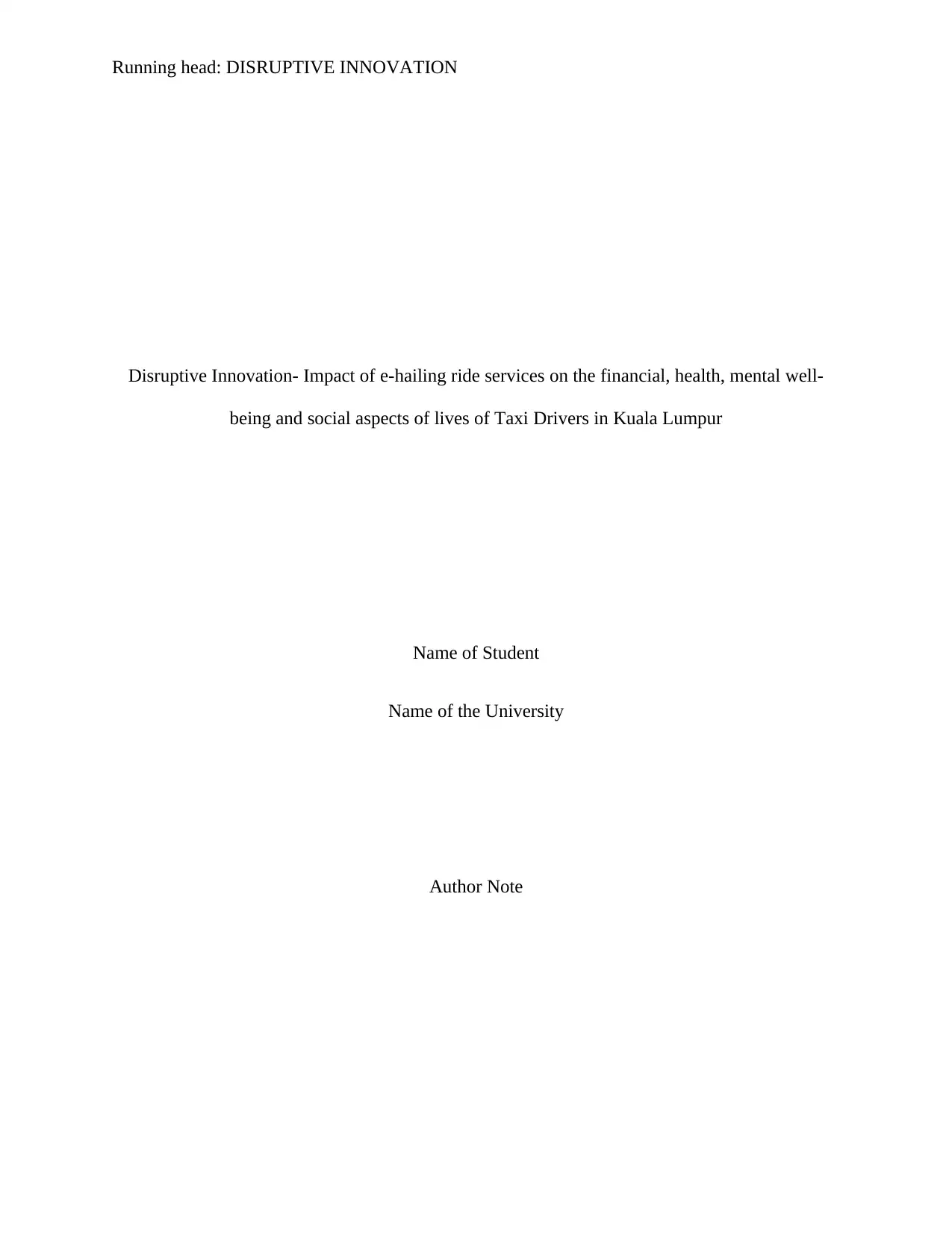
Running head: DISRUPTIVE INNOVATION
Disruptive Innovation- Impact of e-hailing ride services on the financial, health, mental well-
being and social aspects of lives of Taxi Drivers in Kuala Lumpur
Name of Student
Name of the University
Author Note
Disruptive Innovation- Impact of e-hailing ride services on the financial, health, mental well-
being and social aspects of lives of Taxi Drivers in Kuala Lumpur
Name of Student
Name of the University
Author Note
Secure Best Marks with AI Grader
Need help grading? Try our AI Grader for instant feedback on your assignments.
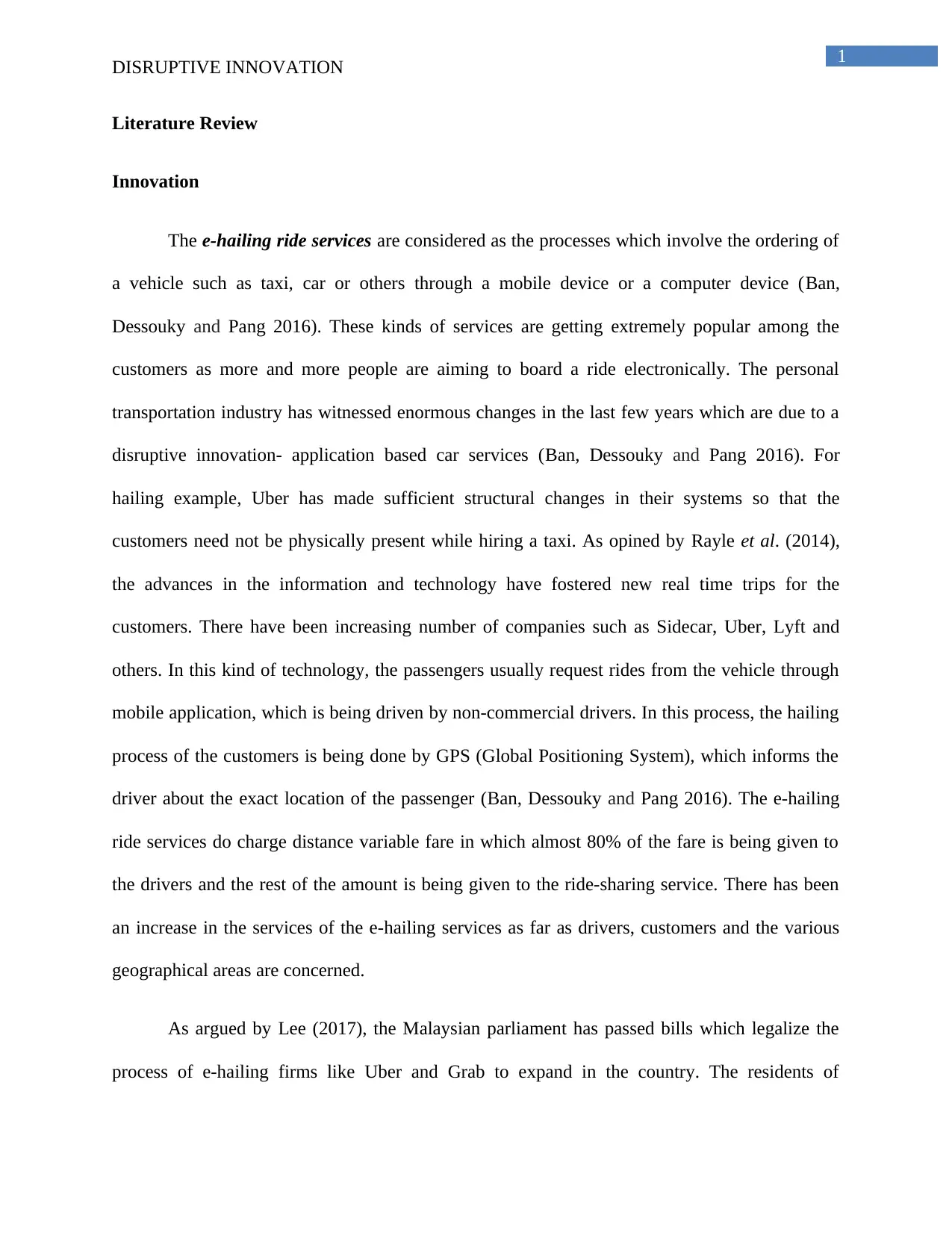
1
DISRUPTIVE INNOVATION
Literature Review
Innovation
The e-hailing ride services are considered as the processes which involve the ordering of
a vehicle such as taxi, car or others through a mobile device or a computer device (Ban,
Dessouky and Pang 2016). These kinds of services are getting extremely popular among the
customers as more and more people are aiming to board a ride electronically. The personal
transportation industry has witnessed enormous changes in the last few years which are due to a
disruptive innovation- application based car services (Ban, Dessouky and Pang 2016). For
hailing example, Uber has made sufficient structural changes in their systems so that the
customers need not be physically present while hiring a taxi. As opined by Rayle et al. (2014),
the advances in the information and technology have fostered new real time trips for the
customers. There have been increasing number of companies such as Sidecar, Uber, Lyft and
others. In this kind of technology, the passengers usually request rides from the vehicle through
mobile application, which is being driven by non-commercial drivers. In this process, the hailing
process of the customers is being done by GPS (Global Positioning System), which informs the
driver about the exact location of the passenger (Ban, Dessouky and Pang 2016). The e-hailing
ride services do charge distance variable fare in which almost 80% of the fare is being given to
the drivers and the rest of the amount is being given to the ride-sharing service. There has been
an increase in the services of the e-hailing services as far as drivers, customers and the various
geographical areas are concerned.
As argued by Lee (2017), the Malaysian parliament has passed bills which legalize the
process of e-hailing firms like Uber and Grab to expand in the country. The residents of
DISRUPTIVE INNOVATION
Literature Review
Innovation
The e-hailing ride services are considered as the processes which involve the ordering of
a vehicle such as taxi, car or others through a mobile device or a computer device (Ban,
Dessouky and Pang 2016). These kinds of services are getting extremely popular among the
customers as more and more people are aiming to board a ride electronically. The personal
transportation industry has witnessed enormous changes in the last few years which are due to a
disruptive innovation- application based car services (Ban, Dessouky and Pang 2016). For
hailing example, Uber has made sufficient structural changes in their systems so that the
customers need not be physically present while hiring a taxi. As opined by Rayle et al. (2014),
the advances in the information and technology have fostered new real time trips for the
customers. There have been increasing number of companies such as Sidecar, Uber, Lyft and
others. In this kind of technology, the passengers usually request rides from the vehicle through
mobile application, which is being driven by non-commercial drivers. In this process, the hailing
process of the customers is being done by GPS (Global Positioning System), which informs the
driver about the exact location of the passenger (Ban, Dessouky and Pang 2016). The e-hailing
ride services do charge distance variable fare in which almost 80% of the fare is being given to
the drivers and the rest of the amount is being given to the ride-sharing service. There has been
an increase in the services of the e-hailing services as far as drivers, customers and the various
geographical areas are concerned.
As argued by Lee (2017), the Malaysian parliament has passed bills which legalize the
process of e-hailing firms like Uber and Grab to expand in the country. The residents of
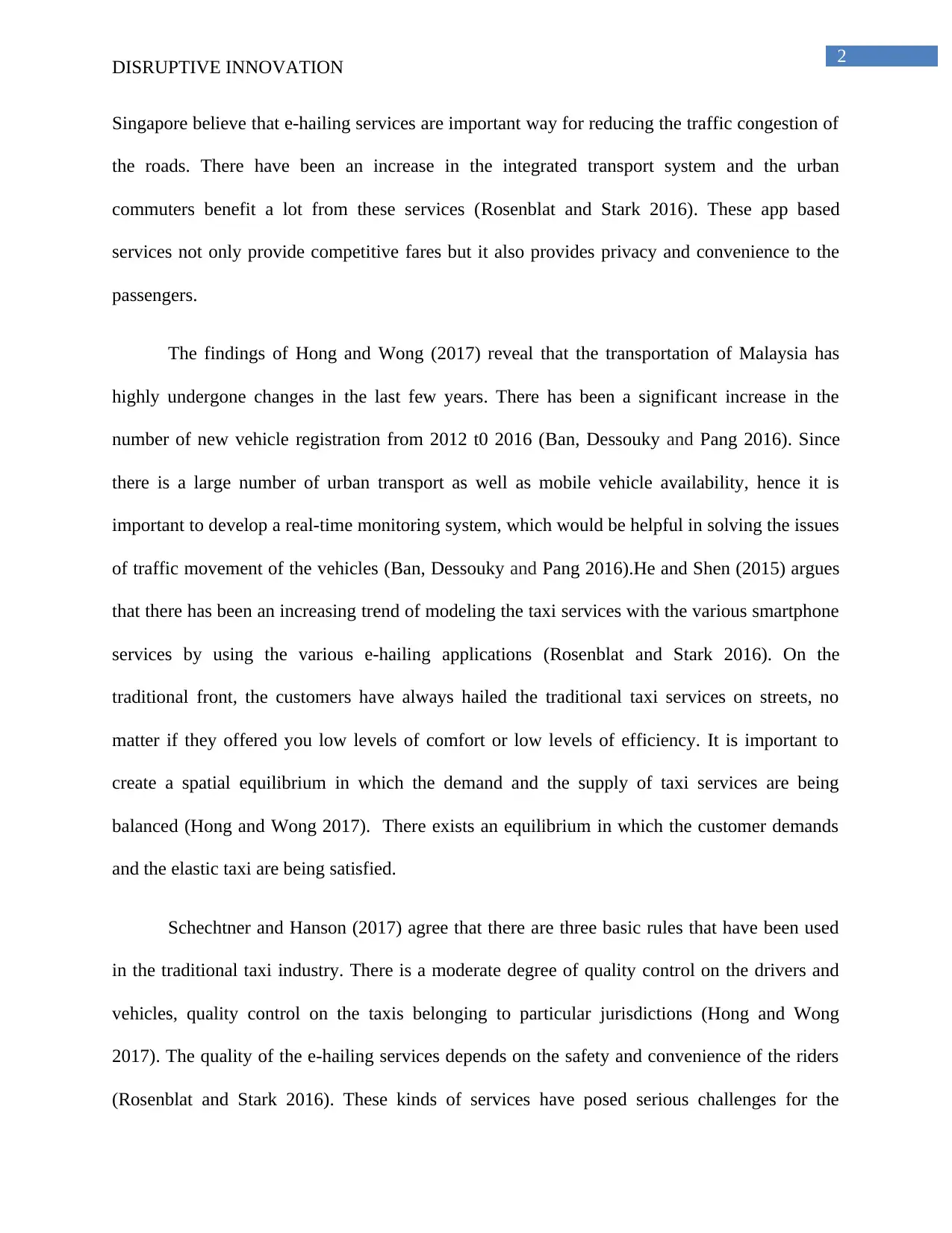
2
DISRUPTIVE INNOVATION
Singapore believe that e-hailing services are important way for reducing the traffic congestion of
the roads. There have been an increase in the integrated transport system and the urban
commuters benefit a lot from these services (Rosenblat and Stark 2016). These app based
services not only provide competitive fares but it also provides privacy and convenience to the
passengers.
The findings of Hong and Wong (2017) reveal that the transportation of Malaysia has
highly undergone changes in the last few years. There has been a significant increase in the
number of new vehicle registration from 2012 t0 2016 (Ban, Dessouky and Pang 2016). Since
there is a large number of urban transport as well as mobile vehicle availability, hence it is
important to develop a real-time monitoring system, which would be helpful in solving the issues
of traffic movement of the vehicles (Ban, Dessouky and Pang 2016).He and Shen (2015) argues
that there has been an increasing trend of modeling the taxi services with the various smartphone
services by using the various e-hailing applications (Rosenblat and Stark 2016). On the
traditional front, the customers have always hailed the traditional taxi services on streets, no
matter if they offered you low levels of comfort or low levels of efficiency. It is important to
create a spatial equilibrium in which the demand and the supply of taxi services are being
balanced (Hong and Wong 2017). There exists an equilibrium in which the customer demands
and the elastic taxi are being satisfied.
Schechtner and Hanson (2017) agree that there are three basic rules that have been used
in the traditional taxi industry. There is a moderate degree of quality control on the drivers and
vehicles, quality control on the taxis belonging to particular jurisdictions (Hong and Wong
2017). The quality of the e-hailing services depends on the safety and convenience of the riders
(Rosenblat and Stark 2016). These kinds of services have posed serious challenges for the
DISRUPTIVE INNOVATION
Singapore believe that e-hailing services are important way for reducing the traffic congestion of
the roads. There have been an increase in the integrated transport system and the urban
commuters benefit a lot from these services (Rosenblat and Stark 2016). These app based
services not only provide competitive fares but it also provides privacy and convenience to the
passengers.
The findings of Hong and Wong (2017) reveal that the transportation of Malaysia has
highly undergone changes in the last few years. There has been a significant increase in the
number of new vehicle registration from 2012 t0 2016 (Ban, Dessouky and Pang 2016). Since
there is a large number of urban transport as well as mobile vehicle availability, hence it is
important to develop a real-time monitoring system, which would be helpful in solving the issues
of traffic movement of the vehicles (Ban, Dessouky and Pang 2016).He and Shen (2015) argues
that there has been an increasing trend of modeling the taxi services with the various smartphone
services by using the various e-hailing applications (Rosenblat and Stark 2016). On the
traditional front, the customers have always hailed the traditional taxi services on streets, no
matter if they offered you low levels of comfort or low levels of efficiency. It is important to
create a spatial equilibrium in which the demand and the supply of taxi services are being
balanced (Hong and Wong 2017). There exists an equilibrium in which the customer demands
and the elastic taxi are being satisfied.
Schechtner and Hanson (2017) agree that there are three basic rules that have been used
in the traditional taxi industry. There is a moderate degree of quality control on the drivers and
vehicles, quality control on the taxis belonging to particular jurisdictions (Hong and Wong
2017). The quality of the e-hailing services depends on the safety and convenience of the riders
(Rosenblat and Stark 2016). These kinds of services have posed serious challenges for the
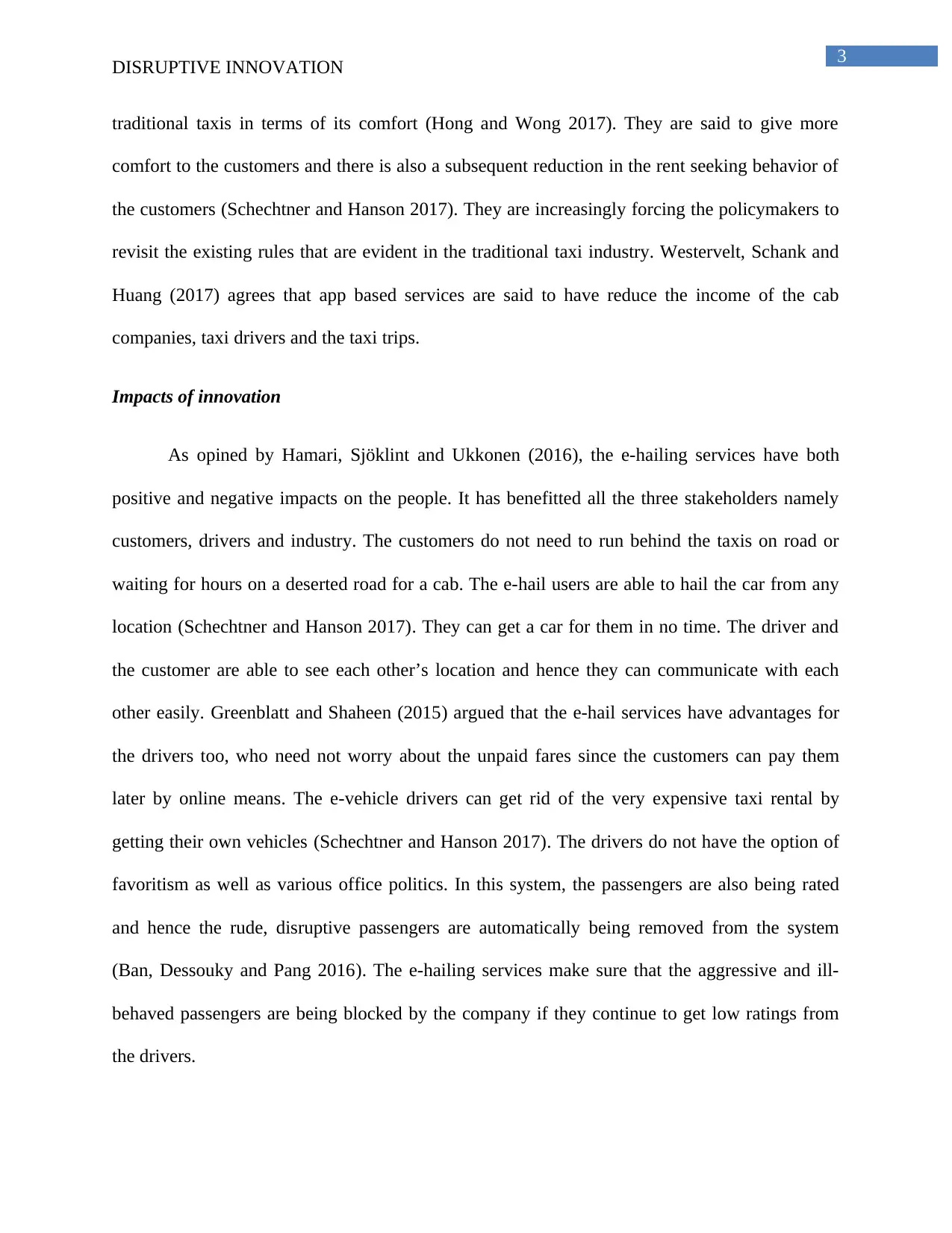
3
DISRUPTIVE INNOVATION
traditional taxis in terms of its comfort (Hong and Wong 2017). They are said to give more
comfort to the customers and there is also a subsequent reduction in the rent seeking behavior of
the customers (Schechtner and Hanson 2017). They are increasingly forcing the policymakers to
revisit the existing rules that are evident in the traditional taxi industry. Westervelt, Schank and
Huang (2017) agrees that app based services are said to have reduce the income of the cab
companies, taxi drivers and the taxi trips.
Impacts of innovation
As opined by Hamari, Sjöklint and Ukkonen (2016), the e-hailing services have both
positive and negative impacts on the people. It has benefitted all the three stakeholders namely
customers, drivers and industry. The customers do not need to run behind the taxis on road or
waiting for hours on a deserted road for a cab. The e-hail users are able to hail the car from any
location (Schechtner and Hanson 2017). They can get a car for them in no time. The driver and
the customer are able to see each other’s location and hence they can communicate with each
other easily. Greenblatt and Shaheen (2015) argued that the e-hail services have advantages for
the drivers too, who need not worry about the unpaid fares since the customers can pay them
later by online means. The e-vehicle drivers can get rid of the very expensive taxi rental by
getting their own vehicles (Schechtner and Hanson 2017). The drivers do not have the option of
favoritism as well as various office politics. In this system, the passengers are also being rated
and hence the rude, disruptive passengers are automatically being removed from the system
(Ban, Dessouky and Pang 2016). The e-hailing services make sure that the aggressive and ill-
behaved passengers are being blocked by the company if they continue to get low ratings from
the drivers.
DISRUPTIVE INNOVATION
traditional taxis in terms of its comfort (Hong and Wong 2017). They are said to give more
comfort to the customers and there is also a subsequent reduction in the rent seeking behavior of
the customers (Schechtner and Hanson 2017). They are increasingly forcing the policymakers to
revisit the existing rules that are evident in the traditional taxi industry. Westervelt, Schank and
Huang (2017) agrees that app based services are said to have reduce the income of the cab
companies, taxi drivers and the taxi trips.
Impacts of innovation
As opined by Hamari, Sjöklint and Ukkonen (2016), the e-hailing services have both
positive and negative impacts on the people. It has benefitted all the three stakeholders namely
customers, drivers and industry. The customers do not need to run behind the taxis on road or
waiting for hours on a deserted road for a cab. The e-hail users are able to hail the car from any
location (Schechtner and Hanson 2017). They can get a car for them in no time. The driver and
the customer are able to see each other’s location and hence they can communicate with each
other easily. Greenblatt and Shaheen (2015) argued that the e-hail services have advantages for
the drivers too, who need not worry about the unpaid fares since the customers can pay them
later by online means. The e-vehicle drivers can get rid of the very expensive taxi rental by
getting their own vehicles (Schechtner and Hanson 2017). The drivers do not have the option of
favoritism as well as various office politics. In this system, the passengers are also being rated
and hence the rude, disruptive passengers are automatically being removed from the system
(Ban, Dessouky and Pang 2016). The e-hailing services make sure that the aggressive and ill-
behaved passengers are being blocked by the company if they continue to get low ratings from
the drivers.
Secure Best Marks with AI Grader
Need help grading? Try our AI Grader for instant feedback on your assignments.
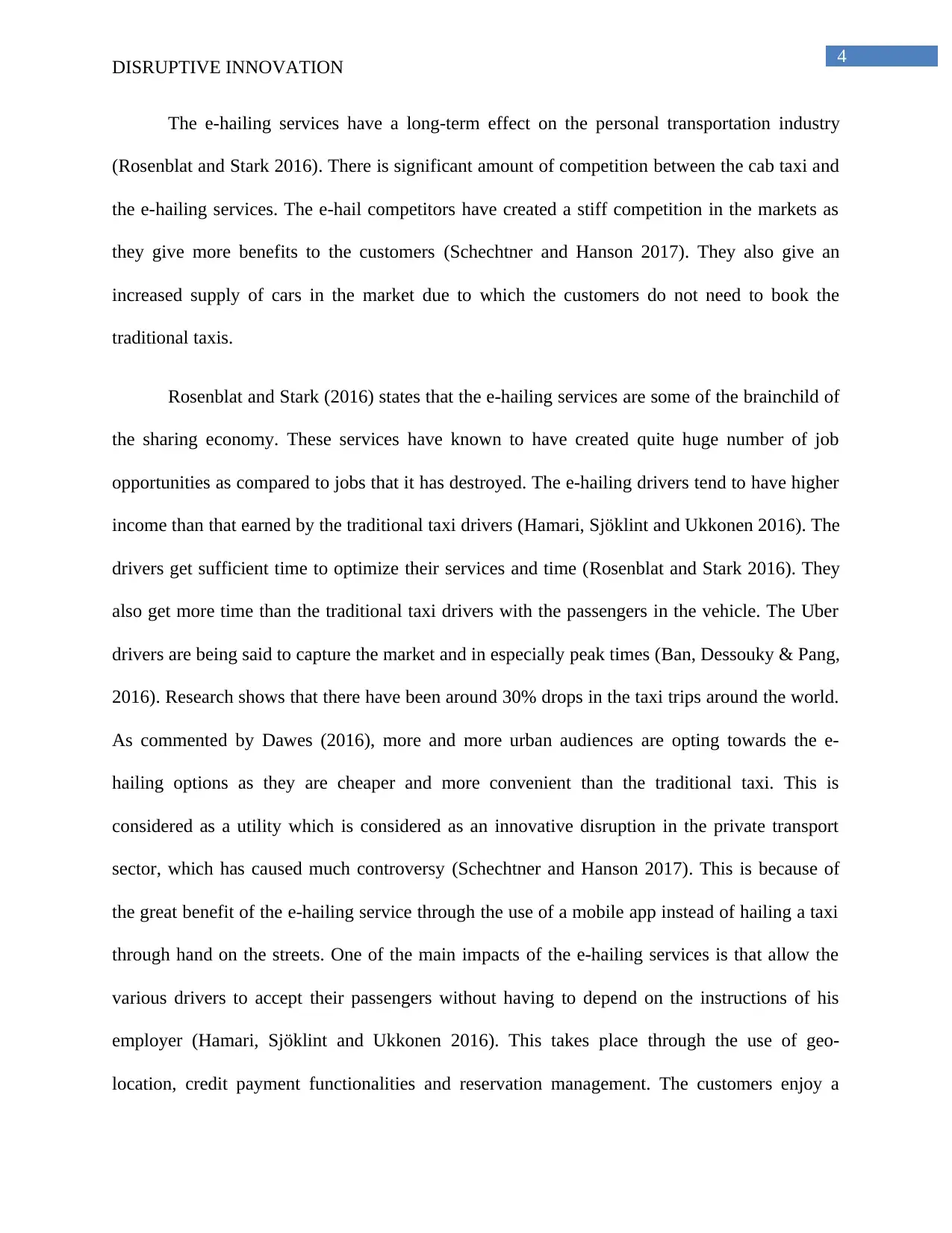
4
DISRUPTIVE INNOVATION
The e-hailing services have a long-term effect on the personal transportation industry
(Rosenblat and Stark 2016). There is significant amount of competition between the cab taxi and
the e-hailing services. The e-hail competitors have created a stiff competition in the markets as
they give more benefits to the customers (Schechtner and Hanson 2017). They also give an
increased supply of cars in the market due to which the customers do not need to book the
traditional taxis.
Rosenblat and Stark (2016) states that the e-hailing services are some of the brainchild of
the sharing economy. These services have known to have created quite huge number of job
opportunities as compared to jobs that it has destroyed. The e-hailing drivers tend to have higher
income than that earned by the traditional taxi drivers (Hamari, Sjöklint and Ukkonen 2016). The
drivers get sufficient time to optimize their services and time (Rosenblat and Stark 2016). They
also get more time than the traditional taxi drivers with the passengers in the vehicle. The Uber
drivers are being said to capture the market and in especially peak times (Ban, Dessouky & Pang,
2016). Research shows that there have been around 30% drops in the taxi trips around the world.
As commented by Dawes (2016), more and more urban audiences are opting towards the e-
hailing options as they are cheaper and more convenient than the traditional taxi. This is
considered as a utility which is considered as an innovative disruption in the private transport
sector, which has caused much controversy (Schechtner and Hanson 2017). This is because of
the great benefit of the e-hailing service through the use of a mobile app instead of hailing a taxi
through hand on the streets. One of the main impacts of the e-hailing services is that allow the
various drivers to accept their passengers without having to depend on the instructions of his
employer (Hamari, Sjöklint and Ukkonen 2016). This takes place through the use of geo-
location, credit payment functionalities and reservation management. The customers enjoy a
DISRUPTIVE INNOVATION
The e-hailing services have a long-term effect on the personal transportation industry
(Rosenblat and Stark 2016). There is significant amount of competition between the cab taxi and
the e-hailing services. The e-hail competitors have created a stiff competition in the markets as
they give more benefits to the customers (Schechtner and Hanson 2017). They also give an
increased supply of cars in the market due to which the customers do not need to book the
traditional taxis.
Rosenblat and Stark (2016) states that the e-hailing services are some of the brainchild of
the sharing economy. These services have known to have created quite huge number of job
opportunities as compared to jobs that it has destroyed. The e-hailing drivers tend to have higher
income than that earned by the traditional taxi drivers (Hamari, Sjöklint and Ukkonen 2016). The
drivers get sufficient time to optimize their services and time (Rosenblat and Stark 2016). They
also get more time than the traditional taxi drivers with the passengers in the vehicle. The Uber
drivers are being said to capture the market and in especially peak times (Ban, Dessouky & Pang,
2016). Research shows that there have been around 30% drops in the taxi trips around the world.
As commented by Dawes (2016), more and more urban audiences are opting towards the e-
hailing options as they are cheaper and more convenient than the traditional taxi. This is
considered as a utility which is considered as an innovative disruption in the private transport
sector, which has caused much controversy (Schechtner and Hanson 2017). This is because of
the great benefit of the e-hailing service through the use of a mobile app instead of hailing a taxi
through hand on the streets. One of the main impacts of the e-hailing services is that allow the
various drivers to accept their passengers without having to depend on the instructions of his
employer (Hamari, Sjöklint and Ukkonen 2016). This takes place through the use of geo-
location, credit payment functionalities and reservation management. The customers enjoy a
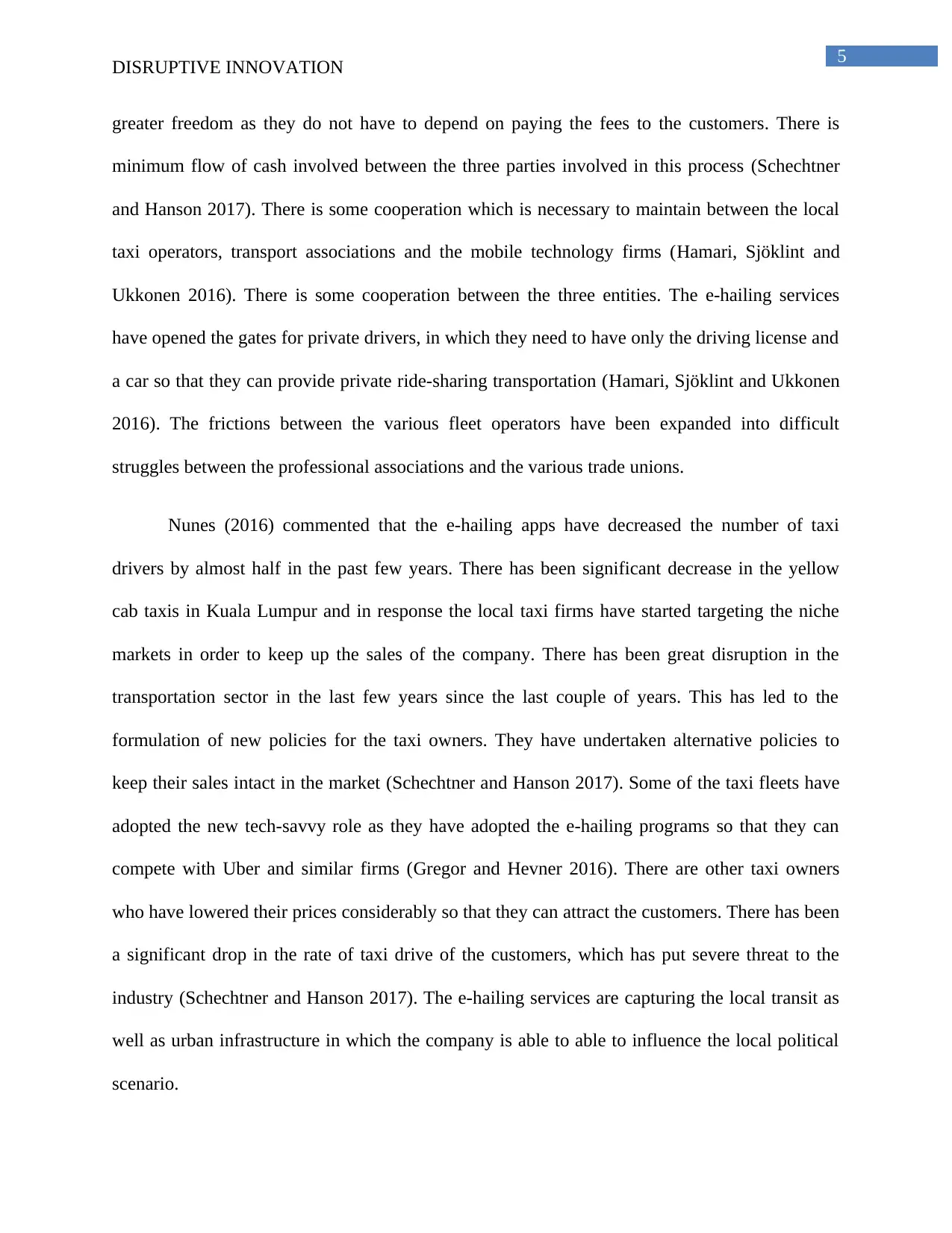
5
DISRUPTIVE INNOVATION
greater freedom as they do not have to depend on paying the fees to the customers. There is
minimum flow of cash involved between the three parties involved in this process (Schechtner
and Hanson 2017). There is some cooperation which is necessary to maintain between the local
taxi operators, transport associations and the mobile technology firms (Hamari, Sjöklint and
Ukkonen 2016). There is some cooperation between the three entities. The e-hailing services
have opened the gates for private drivers, in which they need to have only the driving license and
a car so that they can provide private ride-sharing transportation (Hamari, Sjöklint and Ukkonen
2016). The frictions between the various fleet operators have been expanded into difficult
struggles between the professional associations and the various trade unions.
Nunes (2016) commented that the e-hailing apps have decreased the number of taxi
drivers by almost half in the past few years. There has been significant decrease in the yellow
cab taxis in Kuala Lumpur and in response the local taxi firms have started targeting the niche
markets in order to keep up the sales of the company. There has been great disruption in the
transportation sector in the last few years since the last couple of years. This has led to the
formulation of new policies for the taxi owners. They have undertaken alternative policies to
keep their sales intact in the market (Schechtner and Hanson 2017). Some of the taxi fleets have
adopted the new tech-savvy role as they have adopted the e-hailing programs so that they can
compete with Uber and similar firms (Gregor and Hevner 2016). There are other taxi owners
who have lowered their prices considerably so that they can attract the customers. There has been
a significant drop in the rate of taxi drive of the customers, which has put severe threat to the
industry (Schechtner and Hanson 2017). The e-hailing services are capturing the local transit as
well as urban infrastructure in which the company is able to able to influence the local political
scenario.
DISRUPTIVE INNOVATION
greater freedom as they do not have to depend on paying the fees to the customers. There is
minimum flow of cash involved between the three parties involved in this process (Schechtner
and Hanson 2017). There is some cooperation which is necessary to maintain between the local
taxi operators, transport associations and the mobile technology firms (Hamari, Sjöklint and
Ukkonen 2016). There is some cooperation between the three entities. The e-hailing services
have opened the gates for private drivers, in which they need to have only the driving license and
a car so that they can provide private ride-sharing transportation (Hamari, Sjöklint and Ukkonen
2016). The frictions between the various fleet operators have been expanded into difficult
struggles between the professional associations and the various trade unions.
Nunes (2016) commented that the e-hailing apps have decreased the number of taxi
drivers by almost half in the past few years. There has been significant decrease in the yellow
cab taxis in Kuala Lumpur and in response the local taxi firms have started targeting the niche
markets in order to keep up the sales of the company. There has been great disruption in the
transportation sector in the last few years since the last couple of years. This has led to the
formulation of new policies for the taxi owners. They have undertaken alternative policies to
keep their sales intact in the market (Schechtner and Hanson 2017). Some of the taxi fleets have
adopted the new tech-savvy role as they have adopted the e-hailing programs so that they can
compete with Uber and similar firms (Gregor and Hevner 2016). There are other taxi owners
who have lowered their prices considerably so that they can attract the customers. There has been
a significant drop in the rate of taxi drive of the customers, which has put severe threat to the
industry (Schechtner and Hanson 2017). The e-hailing services are capturing the local transit as
well as urban infrastructure in which the company is able to able to influence the local political
scenario.
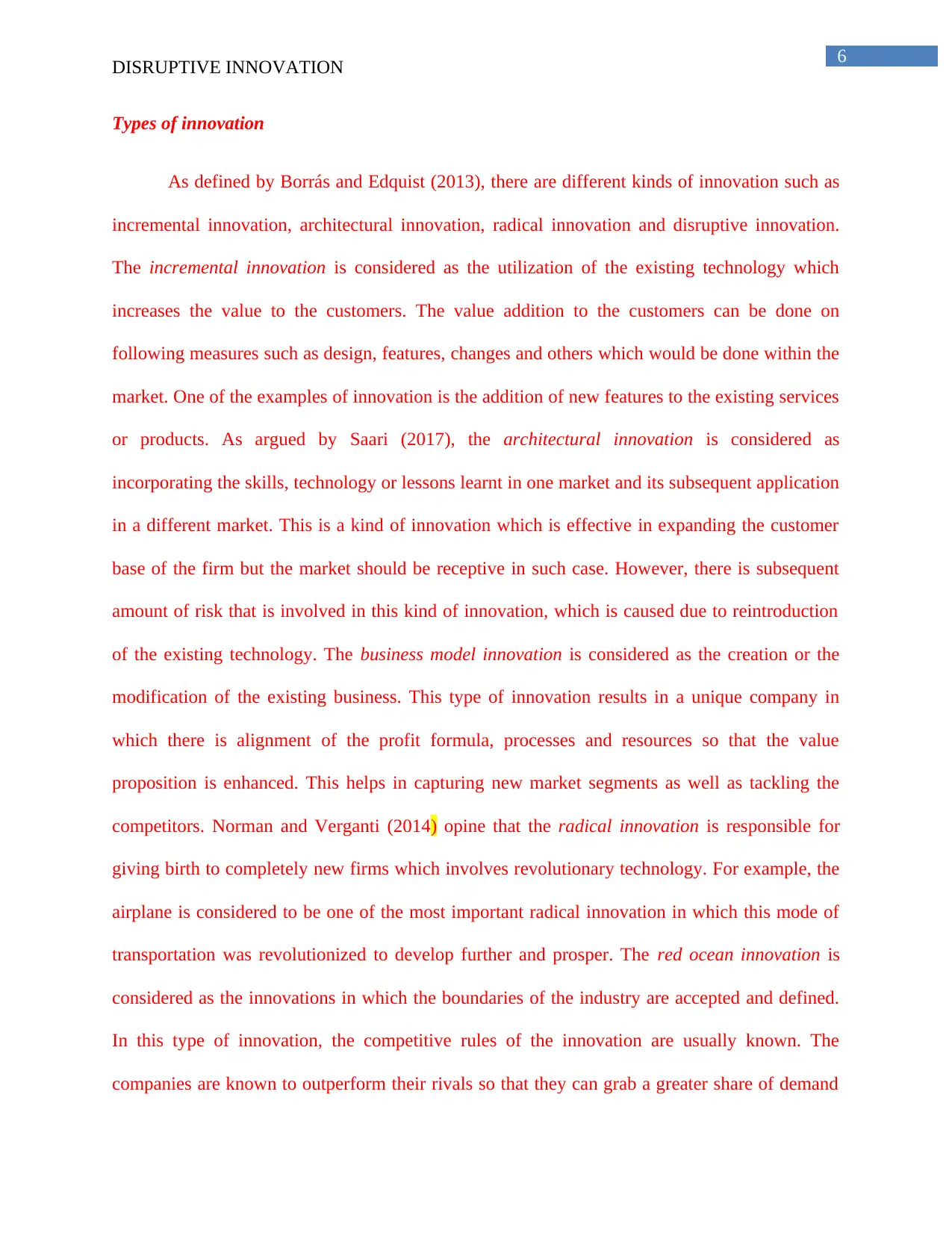
6
DISRUPTIVE INNOVATION
Types of innovation
As defined by Borrás and Edquist (2013), there are different kinds of innovation such as
incremental innovation, architectural innovation, radical innovation and disruptive innovation.
The incremental innovation is considered as the utilization of the existing technology which
increases the value to the customers. The value addition to the customers can be done on
following measures such as design, features, changes and others which would be done within the
market. One of the examples of innovation is the addition of new features to the existing services
or products. As argued by Saari (2017), the architectural innovation is considered as
incorporating the skills, technology or lessons learnt in one market and its subsequent application
in a different market. This is a kind of innovation which is effective in expanding the customer
base of the firm but the market should be receptive in such case. However, there is subsequent
amount of risk that is involved in this kind of innovation, which is caused due to reintroduction
of the existing technology. The business model innovation is considered as the creation or the
modification of the existing business. This type of innovation results in a unique company in
which there is alignment of the profit formula, processes and resources so that the value
proposition is enhanced. This helps in capturing new market segments as well as tackling the
competitors. Norman and Verganti (2014) opine that the radical innovation is responsible for
giving birth to completely new firms which involves revolutionary technology. For example, the
airplane is considered to be one of the most important radical innovation in which this mode of
transportation was revolutionized to develop further and prosper. The red ocean innovation is
considered as the innovations in which the boundaries of the industry are accepted and defined.
In this type of innovation, the competitive rules of the innovation are usually known. The
companies are known to outperform their rivals so that they can grab a greater share of demand
DISRUPTIVE INNOVATION
Types of innovation
As defined by Borrás and Edquist (2013), there are different kinds of innovation such as
incremental innovation, architectural innovation, radical innovation and disruptive innovation.
The incremental innovation is considered as the utilization of the existing technology which
increases the value to the customers. The value addition to the customers can be done on
following measures such as design, features, changes and others which would be done within the
market. One of the examples of innovation is the addition of new features to the existing services
or products. As argued by Saari (2017), the architectural innovation is considered as
incorporating the skills, technology or lessons learnt in one market and its subsequent application
in a different market. This is a kind of innovation which is effective in expanding the customer
base of the firm but the market should be receptive in such case. However, there is subsequent
amount of risk that is involved in this kind of innovation, which is caused due to reintroduction
of the existing technology. The business model innovation is considered as the creation or the
modification of the existing business. This type of innovation results in a unique company in
which there is alignment of the profit formula, processes and resources so that the value
proposition is enhanced. This helps in capturing new market segments as well as tackling the
competitors. Norman and Verganti (2014) opine that the radical innovation is responsible for
giving birth to completely new firms which involves revolutionary technology. For example, the
airplane is considered to be one of the most important radical innovation in which this mode of
transportation was revolutionized to develop further and prosper. The red ocean innovation is
considered as the innovations in which the boundaries of the industry are accepted and defined.
In this type of innovation, the competitive rules of the innovation are usually known. The
companies are known to outperform their rivals so that they can grab a greater share of demand
Paraphrase This Document
Need a fresh take? Get an instant paraphrase of this document with our AI Paraphraser
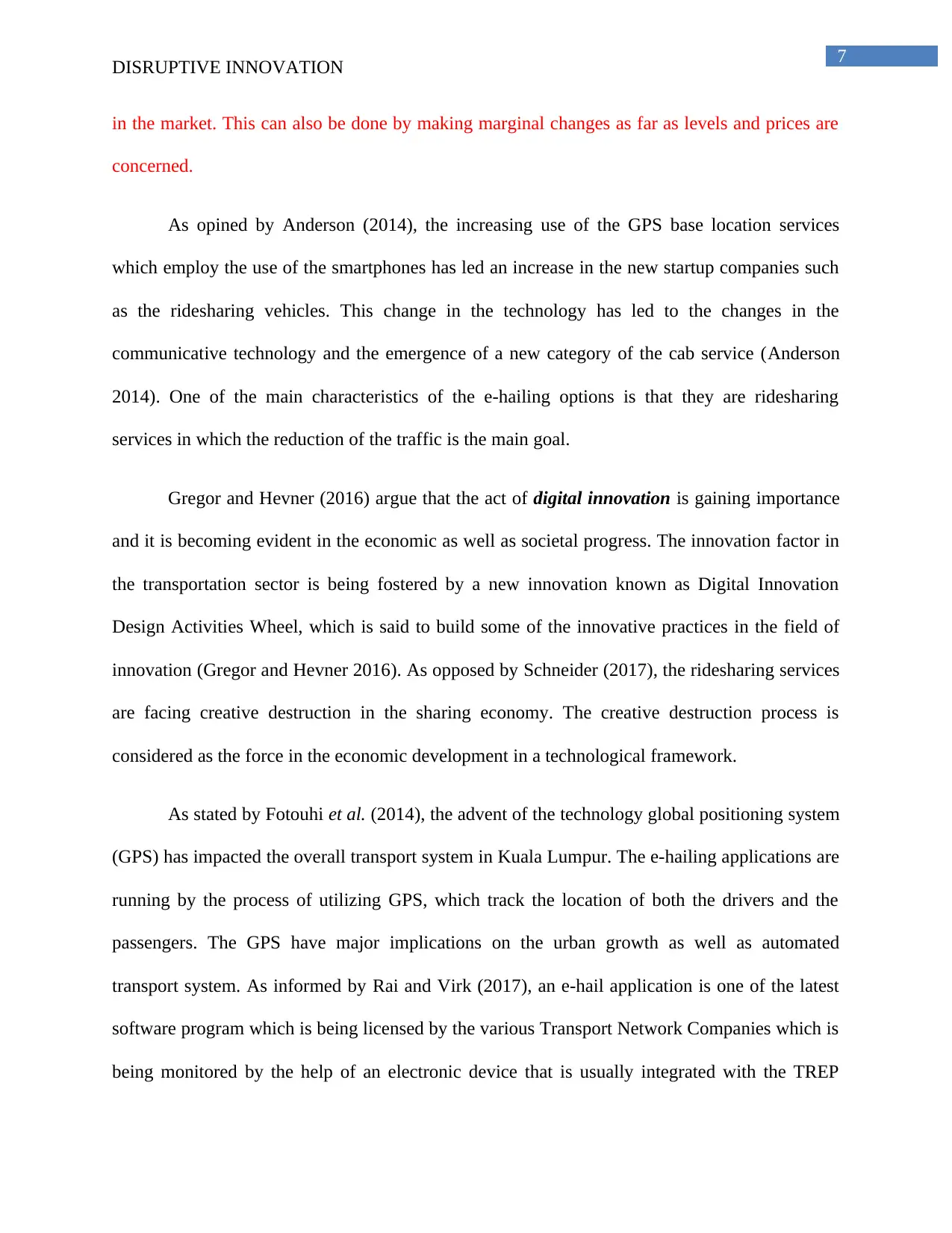
7
DISRUPTIVE INNOVATION
in the market. This can also be done by making marginal changes as far as levels and prices are
concerned.
As opined by Anderson (2014), the increasing use of the GPS base location services
which employ the use of the smartphones has led an increase in the new startup companies such
as the ridesharing vehicles. This change in the technology has led to the changes in the
communicative technology and the emergence of a new category of the cab service (Anderson
2014). One of the main characteristics of the e-hailing options is that they are ridesharing
services in which the reduction of the traffic is the main goal.
Gregor and Hevner (2016) argue that the act of digital innovation is gaining importance
and it is becoming evident in the economic as well as societal progress. The innovation factor in
the transportation sector is being fostered by a new innovation known as Digital Innovation
Design Activities Wheel, which is said to build some of the innovative practices in the field of
innovation (Gregor and Hevner 2016). As opposed by Schneider (2017), the ridesharing services
are facing creative destruction in the sharing economy. The creative destruction process is
considered as the force in the economic development in a technological framework.
As stated by Fotouhi et al. (2014), the advent of the technology global positioning system
(GPS) has impacted the overall transport system in Kuala Lumpur. The e-hailing applications are
running by the process of utilizing GPS, which track the location of both the drivers and the
passengers. The GPS have major implications on the urban growth as well as automated
transport system. As informed by Rai and Virk (2017), an e-hail application is one of the latest
software program which is being licensed by the various Transport Network Companies which is
being monitored by the help of an electronic device that is usually integrated with the TREP
DISRUPTIVE INNOVATION
in the market. This can also be done by making marginal changes as far as levels and prices are
concerned.
As opined by Anderson (2014), the increasing use of the GPS base location services
which employ the use of the smartphones has led an increase in the new startup companies such
as the ridesharing vehicles. This change in the technology has led to the changes in the
communicative technology and the emergence of a new category of the cab service (Anderson
2014). One of the main characteristics of the e-hailing options is that they are ridesharing
services in which the reduction of the traffic is the main goal.
Gregor and Hevner (2016) argue that the act of digital innovation is gaining importance
and it is becoming evident in the economic as well as societal progress. The innovation factor in
the transportation sector is being fostered by a new innovation known as Digital Innovation
Design Activities Wheel, which is said to build some of the innovative practices in the field of
innovation (Gregor and Hevner 2016). As opposed by Schneider (2017), the ridesharing services
are facing creative destruction in the sharing economy. The creative destruction process is
considered as the force in the economic development in a technological framework.
As stated by Fotouhi et al. (2014), the advent of the technology global positioning system
(GPS) has impacted the overall transport system in Kuala Lumpur. The e-hailing applications are
running by the process of utilizing GPS, which track the location of both the drivers and the
passengers. The GPS have major implications on the urban growth as well as automated
transport system. As informed by Rai and Virk (2017), an e-hail application is one of the latest
software program which is being licensed by the various Transport Network Companies which is
being monitored by the help of an electronic device that is usually integrated with the TREP
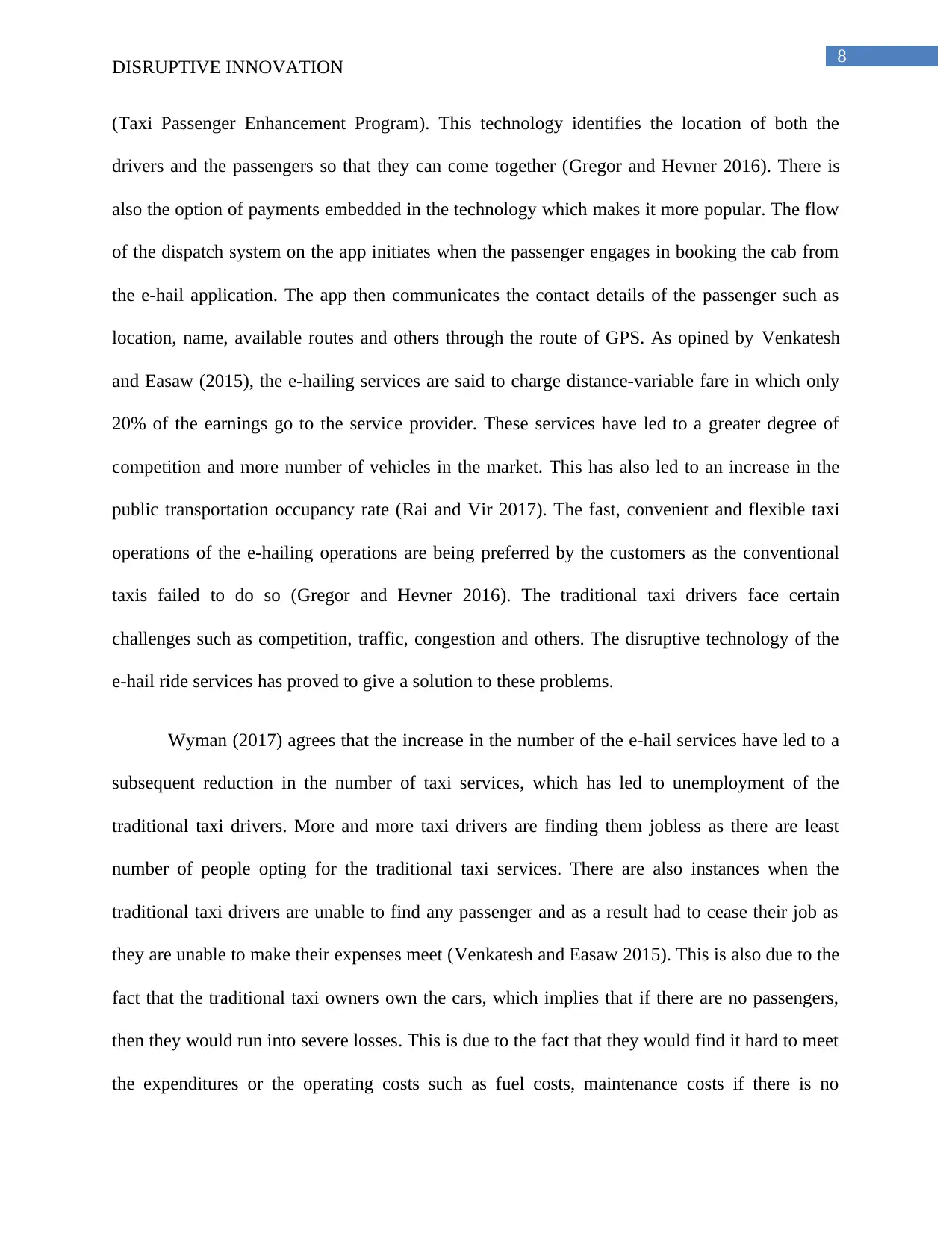
8
DISRUPTIVE INNOVATION
(Taxi Passenger Enhancement Program). This technology identifies the location of both the
drivers and the passengers so that they can come together (Gregor and Hevner 2016). There is
also the option of payments embedded in the technology which makes it more popular. The flow
of the dispatch system on the app initiates when the passenger engages in booking the cab from
the e-hail application. The app then communicates the contact details of the passenger such as
location, name, available routes and others through the route of GPS. As opined by Venkatesh
and Easaw (2015), the e-hailing services are said to charge distance-variable fare in which only
20% of the earnings go to the service provider. These services have led to a greater degree of
competition and more number of vehicles in the market. This has also led to an increase in the
public transportation occupancy rate (Rai and Vir 2017). The fast, convenient and flexible taxi
operations of the e-hailing operations are being preferred by the customers as the conventional
taxis failed to do so (Gregor and Hevner 2016). The traditional taxi drivers face certain
challenges such as competition, traffic, congestion and others. The disruptive technology of the
e-hail ride services has proved to give a solution to these problems.
Wyman (2017) agrees that the increase in the number of the e-hail services have led to a
subsequent reduction in the number of taxi services, which has led to unemployment of the
traditional taxi drivers. More and more taxi drivers are finding them jobless as there are least
number of people opting for the traditional taxi services. There are also instances when the
traditional taxi drivers are unable to find any passenger and as a result had to cease their job as
they are unable to make their expenses meet (Venkatesh and Easaw 2015). This is also due to the
fact that the traditional taxi owners own the cars, which implies that if there are no passengers,
then they would run into severe losses. This is due to the fact that they would find it hard to meet
the expenditures or the operating costs such as fuel costs, maintenance costs if there is no
DISRUPTIVE INNOVATION
(Taxi Passenger Enhancement Program). This technology identifies the location of both the
drivers and the passengers so that they can come together (Gregor and Hevner 2016). There is
also the option of payments embedded in the technology which makes it more popular. The flow
of the dispatch system on the app initiates when the passenger engages in booking the cab from
the e-hail application. The app then communicates the contact details of the passenger such as
location, name, available routes and others through the route of GPS. As opined by Venkatesh
and Easaw (2015), the e-hailing services are said to charge distance-variable fare in which only
20% of the earnings go to the service provider. These services have led to a greater degree of
competition and more number of vehicles in the market. This has also led to an increase in the
public transportation occupancy rate (Rai and Vir 2017). The fast, convenient and flexible taxi
operations of the e-hailing operations are being preferred by the customers as the conventional
taxis failed to do so (Gregor and Hevner 2016). The traditional taxi drivers face certain
challenges such as competition, traffic, congestion and others. The disruptive technology of the
e-hail ride services has proved to give a solution to these problems.
Wyman (2017) agrees that the increase in the number of the e-hail services have led to a
subsequent reduction in the number of taxi services, which has led to unemployment of the
traditional taxi drivers. More and more taxi drivers are finding them jobless as there are least
number of people opting for the traditional taxi services. There are also instances when the
traditional taxi drivers are unable to find any passenger and as a result had to cease their job as
they are unable to make their expenses meet (Venkatesh and Easaw 2015). This is also due to the
fact that the traditional taxi owners own the cars, which implies that if there are no passengers,
then they would run into severe losses. This is due to the fact that they would find it hard to meet
the expenditures or the operating costs such as fuel costs, maintenance costs if there is no
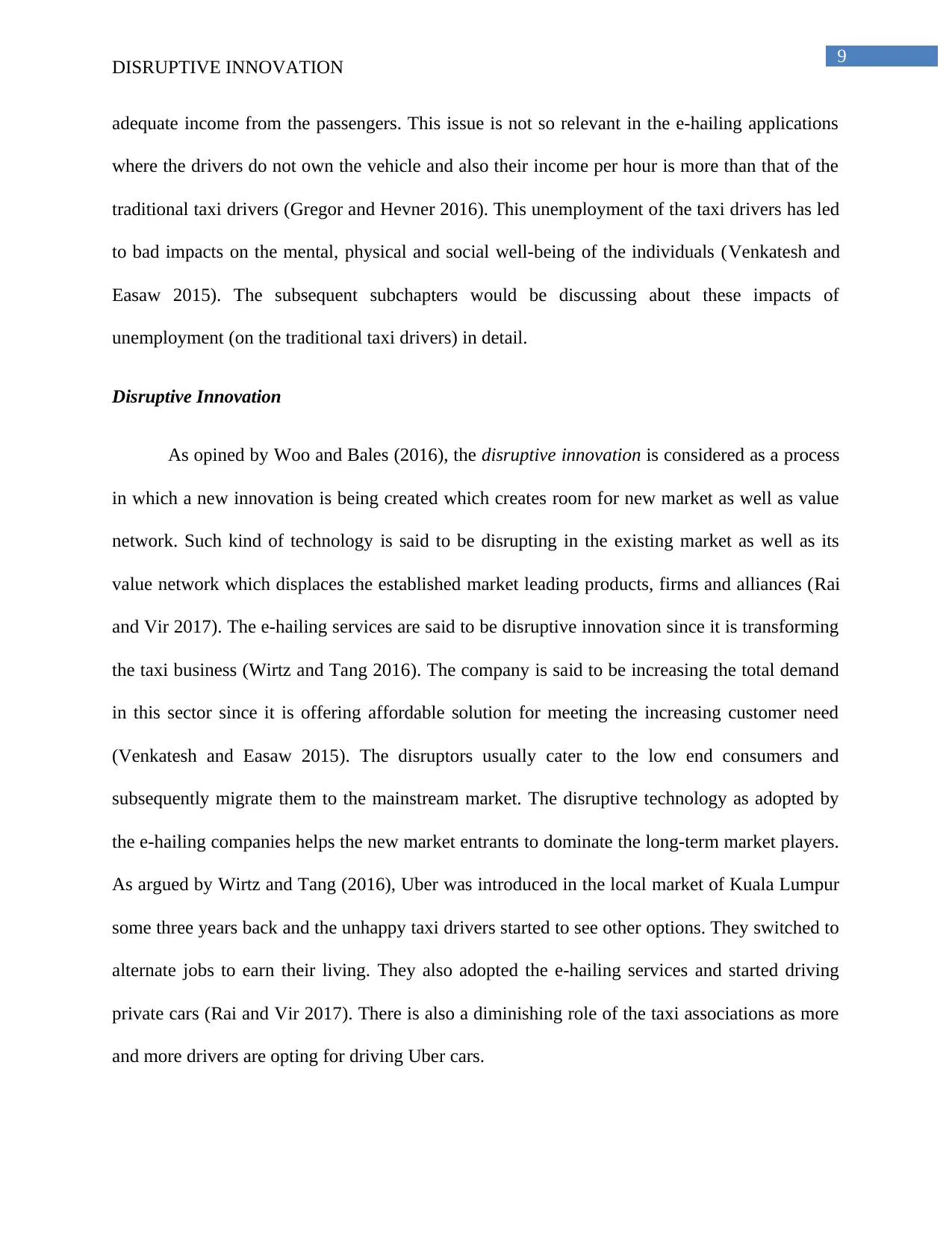
9
DISRUPTIVE INNOVATION
adequate income from the passengers. This issue is not so relevant in the e-hailing applications
where the drivers do not own the vehicle and also their income per hour is more than that of the
traditional taxi drivers (Gregor and Hevner 2016). This unemployment of the taxi drivers has led
to bad impacts on the mental, physical and social well-being of the individuals (Venkatesh and
Easaw 2015). The subsequent subchapters would be discussing about these impacts of
unemployment (on the traditional taxi drivers) in detail.
Disruptive Innovation
As opined by Woo and Bales (2016), the disruptive innovation is considered as a process
in which a new innovation is being created which creates room for new market as well as value
network. Such kind of technology is said to be disrupting in the existing market as well as its
value network which displaces the established market leading products, firms and alliances (Rai
and Vir 2017). The e-hailing services are said to be disruptive innovation since it is transforming
the taxi business (Wirtz and Tang 2016). The company is said to be increasing the total demand
in this sector since it is offering affordable solution for meeting the increasing customer need
(Venkatesh and Easaw 2015). The disruptors usually cater to the low end consumers and
subsequently migrate them to the mainstream market. The disruptive technology as adopted by
the e-hailing companies helps the new market entrants to dominate the long-term market players.
As argued by Wirtz and Tang (2016), Uber was introduced in the local market of Kuala Lumpur
some three years back and the unhappy taxi drivers started to see other options. They switched to
alternate jobs to earn their living. They also adopted the e-hailing services and started driving
private cars (Rai and Vir 2017). There is also a diminishing role of the taxi associations as more
and more drivers are opting for driving Uber cars.
DISRUPTIVE INNOVATION
adequate income from the passengers. This issue is not so relevant in the e-hailing applications
where the drivers do not own the vehicle and also their income per hour is more than that of the
traditional taxi drivers (Gregor and Hevner 2016). This unemployment of the taxi drivers has led
to bad impacts on the mental, physical and social well-being of the individuals (Venkatesh and
Easaw 2015). The subsequent subchapters would be discussing about these impacts of
unemployment (on the traditional taxi drivers) in detail.
Disruptive Innovation
As opined by Woo and Bales (2016), the disruptive innovation is considered as a process
in which a new innovation is being created which creates room for new market as well as value
network. Such kind of technology is said to be disrupting in the existing market as well as its
value network which displaces the established market leading products, firms and alliances (Rai
and Vir 2017). The e-hailing services are said to be disruptive innovation since it is transforming
the taxi business (Wirtz and Tang 2016). The company is said to be increasing the total demand
in this sector since it is offering affordable solution for meeting the increasing customer need
(Venkatesh and Easaw 2015). The disruptors usually cater to the low end consumers and
subsequently migrate them to the mainstream market. The disruptive technology as adopted by
the e-hailing companies helps the new market entrants to dominate the long-term market players.
As argued by Wirtz and Tang (2016), Uber was introduced in the local market of Kuala Lumpur
some three years back and the unhappy taxi drivers started to see other options. They switched to
alternate jobs to earn their living. They also adopted the e-hailing services and started driving
private cars (Rai and Vir 2017). There is also a diminishing role of the taxi associations as more
and more drivers are opting for driving Uber cars.
Secure Best Marks with AI Grader
Need help grading? Try our AI Grader for instant feedback on your assignments.
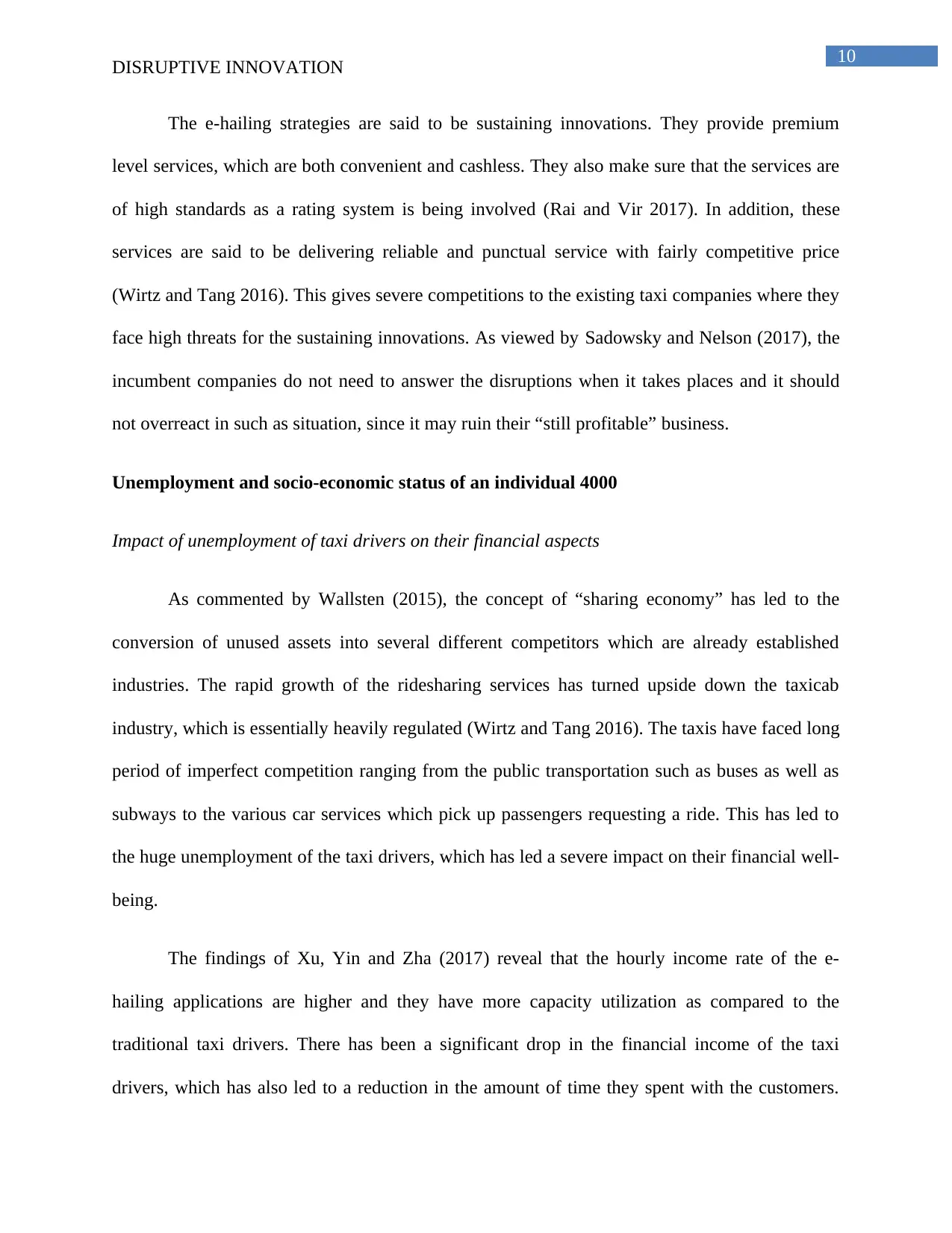
10
DISRUPTIVE INNOVATION
The e-hailing strategies are said to be sustaining innovations. They provide premium
level services, which are both convenient and cashless. They also make sure that the services are
of high standards as a rating system is being involved (Rai and Vir 2017). In addition, these
services are said to be delivering reliable and punctual service with fairly competitive price
(Wirtz and Tang 2016). This gives severe competitions to the existing taxi companies where they
face high threats for the sustaining innovations. As viewed by Sadowsky and Nelson (2017), the
incumbent companies do not need to answer the disruptions when it takes places and it should
not overreact in such as situation, since it may ruin their “still profitable” business.
Unemployment and socio-economic status of an individual 4000
Impact of unemployment of taxi drivers on their financial aspects
As commented by Wallsten (2015), the concept of “sharing economy” has led to the
conversion of unused assets into several different competitors which are already established
industries. The rapid growth of the ridesharing services has turned upside down the taxicab
industry, which is essentially heavily regulated (Wirtz and Tang 2016). The taxis have faced long
period of imperfect competition ranging from the public transportation such as buses as well as
subways to the various car services which pick up passengers requesting a ride. This has led to
the huge unemployment of the taxi drivers, which has led a severe impact on their financial well-
being.
The findings of Xu, Yin and Zha (2017) reveal that the hourly income rate of the e-
hailing applications are higher and they have more capacity utilization as compared to the
traditional taxi drivers. There has been a significant drop in the financial income of the taxi
drivers, which has also led to a reduction in the amount of time they spent with the customers.
DISRUPTIVE INNOVATION
The e-hailing strategies are said to be sustaining innovations. They provide premium
level services, which are both convenient and cashless. They also make sure that the services are
of high standards as a rating system is being involved (Rai and Vir 2017). In addition, these
services are said to be delivering reliable and punctual service with fairly competitive price
(Wirtz and Tang 2016). This gives severe competitions to the existing taxi companies where they
face high threats for the sustaining innovations. As viewed by Sadowsky and Nelson (2017), the
incumbent companies do not need to answer the disruptions when it takes places and it should
not overreact in such as situation, since it may ruin their “still profitable” business.
Unemployment and socio-economic status of an individual 4000
Impact of unemployment of taxi drivers on their financial aspects
As commented by Wallsten (2015), the concept of “sharing economy” has led to the
conversion of unused assets into several different competitors which are already established
industries. The rapid growth of the ridesharing services has turned upside down the taxicab
industry, which is essentially heavily regulated (Wirtz and Tang 2016). The taxis have faced long
period of imperfect competition ranging from the public transportation such as buses as well as
subways to the various car services which pick up passengers requesting a ride. This has led to
the huge unemployment of the taxi drivers, which has led a severe impact on their financial well-
being.
The findings of Xu, Yin and Zha (2017) reveal that the hourly income rate of the e-
hailing applications are higher and they have more capacity utilization as compared to the
traditional taxi drivers. There has been a significant drop in the financial income of the taxi
drivers, which has also led to a reduction in the amount of time they spent with the customers.
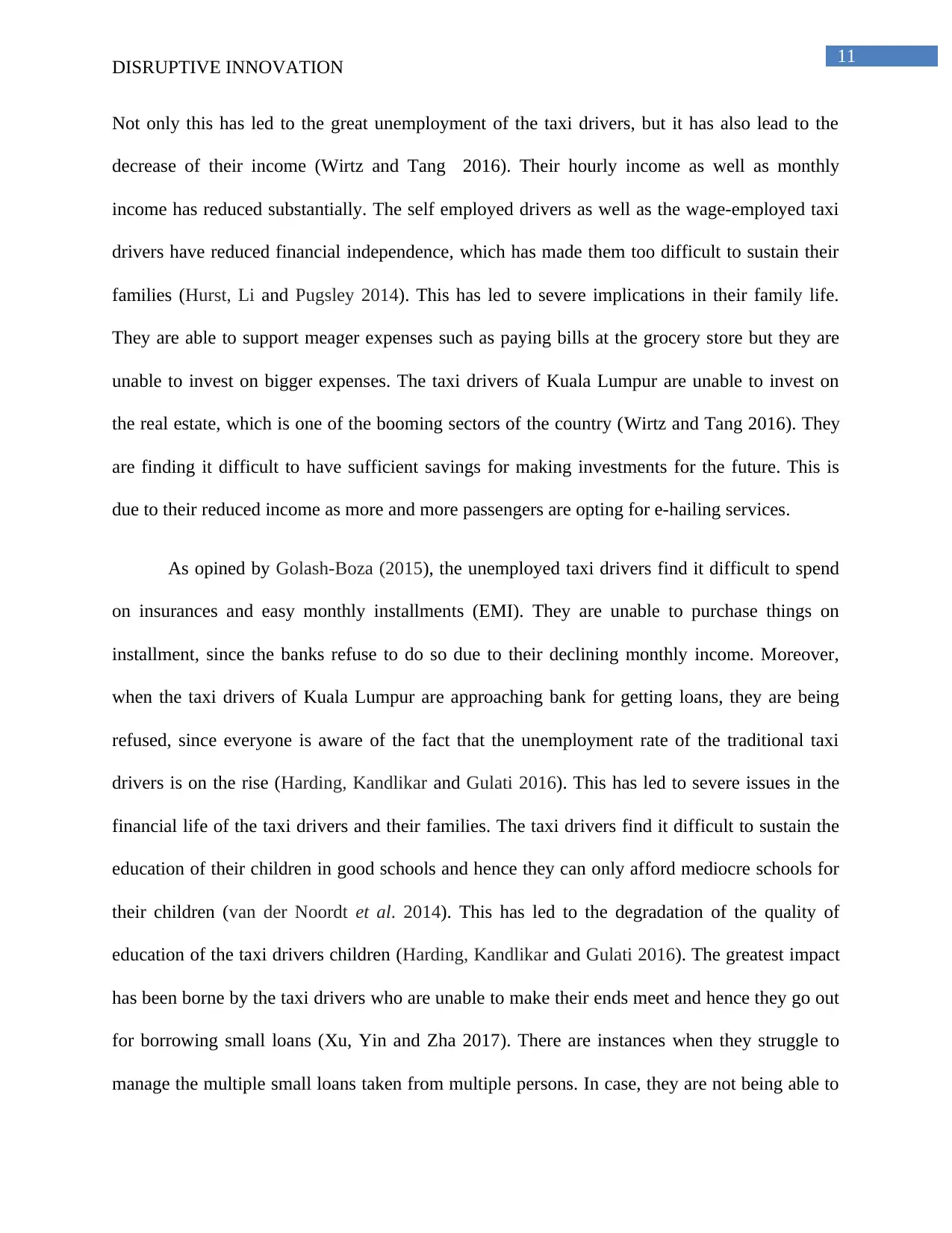
11
DISRUPTIVE INNOVATION
Not only this has led to the great unemployment of the taxi drivers, but it has also lead to the
decrease of their income (Wirtz and Tang 2016). Their hourly income as well as monthly
income has reduced substantially. The self employed drivers as well as the wage-employed taxi
drivers have reduced financial independence, which has made them too difficult to sustain their
families (Hurst, Li and Pugsley 2014). This has led to severe implications in their family life.
They are able to support meager expenses such as paying bills at the grocery store but they are
unable to invest on bigger expenses. The taxi drivers of Kuala Lumpur are unable to invest on
the real estate, which is one of the booming sectors of the country (Wirtz and Tang 2016). They
are finding it difficult to have sufficient savings for making investments for the future. This is
due to their reduced income as more and more passengers are opting for e-hailing services.
As opined by Golash-Boza (2015), the unemployed taxi drivers find it difficult to spend
on insurances and easy monthly installments (EMI). They are unable to purchase things on
installment, since the banks refuse to do so due to their declining monthly income. Moreover,
when the taxi drivers of Kuala Lumpur are approaching bank for getting loans, they are being
refused, since everyone is aware of the fact that the unemployment rate of the traditional taxi
drivers is on the rise (Harding, Kandlikar and Gulati 2016). This has led to severe issues in the
financial life of the taxi drivers and their families. The taxi drivers find it difficult to sustain the
education of their children in good schools and hence they can only afford mediocre schools for
their children (van der Noordt et al. 2014). This has led to the degradation of the quality of
education of the taxi drivers children (Harding, Kandlikar and Gulati 2016). The greatest impact
has been borne by the taxi drivers who are unable to make their ends meet and hence they go out
for borrowing small loans (Xu, Yin and Zha 2017). There are instances when they struggle to
manage the multiple small loans taken from multiple persons. In case, they are not being able to
DISRUPTIVE INNOVATION
Not only this has led to the great unemployment of the taxi drivers, but it has also lead to the
decrease of their income (Wirtz and Tang 2016). Their hourly income as well as monthly
income has reduced substantially. The self employed drivers as well as the wage-employed taxi
drivers have reduced financial independence, which has made them too difficult to sustain their
families (Hurst, Li and Pugsley 2014). This has led to severe implications in their family life.
They are able to support meager expenses such as paying bills at the grocery store but they are
unable to invest on bigger expenses. The taxi drivers of Kuala Lumpur are unable to invest on
the real estate, which is one of the booming sectors of the country (Wirtz and Tang 2016). They
are finding it difficult to have sufficient savings for making investments for the future. This is
due to their reduced income as more and more passengers are opting for e-hailing services.
As opined by Golash-Boza (2015), the unemployed taxi drivers find it difficult to spend
on insurances and easy monthly installments (EMI). They are unable to purchase things on
installment, since the banks refuse to do so due to their declining monthly income. Moreover,
when the taxi drivers of Kuala Lumpur are approaching bank for getting loans, they are being
refused, since everyone is aware of the fact that the unemployment rate of the traditional taxi
drivers is on the rise (Harding, Kandlikar and Gulati 2016). This has led to severe issues in the
financial life of the taxi drivers and their families. The taxi drivers find it difficult to sustain the
education of their children in good schools and hence they can only afford mediocre schools for
their children (van der Noordt et al. 2014). This has led to the degradation of the quality of
education of the taxi drivers children (Harding, Kandlikar and Gulati 2016). The greatest impact
has been borne by the taxi drivers who are unable to make their ends meet and hence they go out
for borrowing small loans (Xu, Yin and Zha 2017). There are instances when they struggle to
manage the multiple small loans taken from multiple persons. In case, they are not being able to
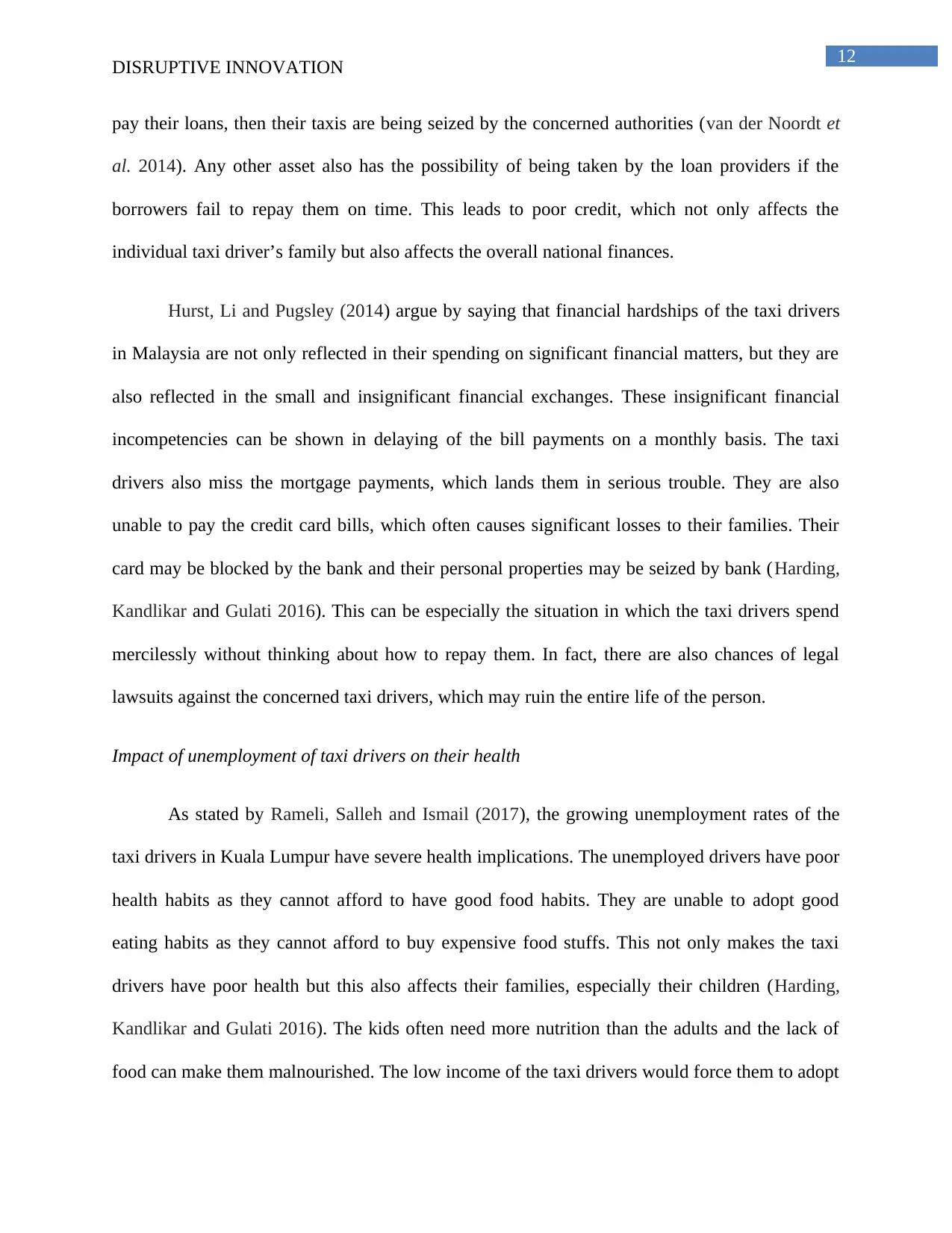
12
DISRUPTIVE INNOVATION
pay their loans, then their taxis are being seized by the concerned authorities (van der Noordt et
al. 2014). Any other asset also has the possibility of being taken by the loan providers if the
borrowers fail to repay them on time. This leads to poor credit, which not only affects the
individual taxi driver’s family but also affects the overall national finances.
Hurst, Li and Pugsley (2014) argue by saying that financial hardships of the taxi drivers
in Malaysia are not only reflected in their spending on significant financial matters, but they are
also reflected in the small and insignificant financial exchanges. These insignificant financial
incompetencies can be shown in delaying of the bill payments on a monthly basis. The taxi
drivers also miss the mortgage payments, which lands them in serious trouble. They are also
unable to pay the credit card bills, which often causes significant losses to their families. Their
card may be blocked by the bank and their personal properties may be seized by bank (Harding,
Kandlikar and Gulati 2016). This can be especially the situation in which the taxi drivers spend
mercilessly without thinking about how to repay them. In fact, there are also chances of legal
lawsuits against the concerned taxi drivers, which may ruin the entire life of the person.
Impact of unemployment of taxi drivers on their health
As stated by Rameli, Salleh and Ismail (2017), the growing unemployment rates of the
taxi drivers in Kuala Lumpur have severe health implications. The unemployed drivers have poor
health habits as they cannot afford to have good food habits. They are unable to adopt good
eating habits as they cannot afford to buy expensive food stuffs. This not only makes the taxi
drivers have poor health but this also affects their families, especially their children (Harding,
Kandlikar and Gulati 2016). The kids often need more nutrition than the adults and the lack of
food can make them malnourished. The low income of the taxi drivers would force them to adopt
DISRUPTIVE INNOVATION
pay their loans, then their taxis are being seized by the concerned authorities (van der Noordt et
al. 2014). Any other asset also has the possibility of being taken by the loan providers if the
borrowers fail to repay them on time. This leads to poor credit, which not only affects the
individual taxi driver’s family but also affects the overall national finances.
Hurst, Li and Pugsley (2014) argue by saying that financial hardships of the taxi drivers
in Malaysia are not only reflected in their spending on significant financial matters, but they are
also reflected in the small and insignificant financial exchanges. These insignificant financial
incompetencies can be shown in delaying of the bill payments on a monthly basis. The taxi
drivers also miss the mortgage payments, which lands them in serious trouble. They are also
unable to pay the credit card bills, which often causes significant losses to their families. Their
card may be blocked by the bank and their personal properties may be seized by bank (Harding,
Kandlikar and Gulati 2016). This can be especially the situation in which the taxi drivers spend
mercilessly without thinking about how to repay them. In fact, there are also chances of legal
lawsuits against the concerned taxi drivers, which may ruin the entire life of the person.
Impact of unemployment of taxi drivers on their health
As stated by Rameli, Salleh and Ismail (2017), the growing unemployment rates of the
taxi drivers in Kuala Lumpur have severe health implications. The unemployed drivers have poor
health habits as they cannot afford to have good food habits. They are unable to adopt good
eating habits as they cannot afford to buy expensive food stuffs. This not only makes the taxi
drivers have poor health but this also affects their families, especially their children (Harding,
Kandlikar and Gulati 2016). The kids often need more nutrition than the adults and the lack of
food can make them malnourished. The low income of the taxi drivers would force them to adopt
Paraphrase This Document
Need a fresh take? Get an instant paraphrase of this document with our AI Paraphraser
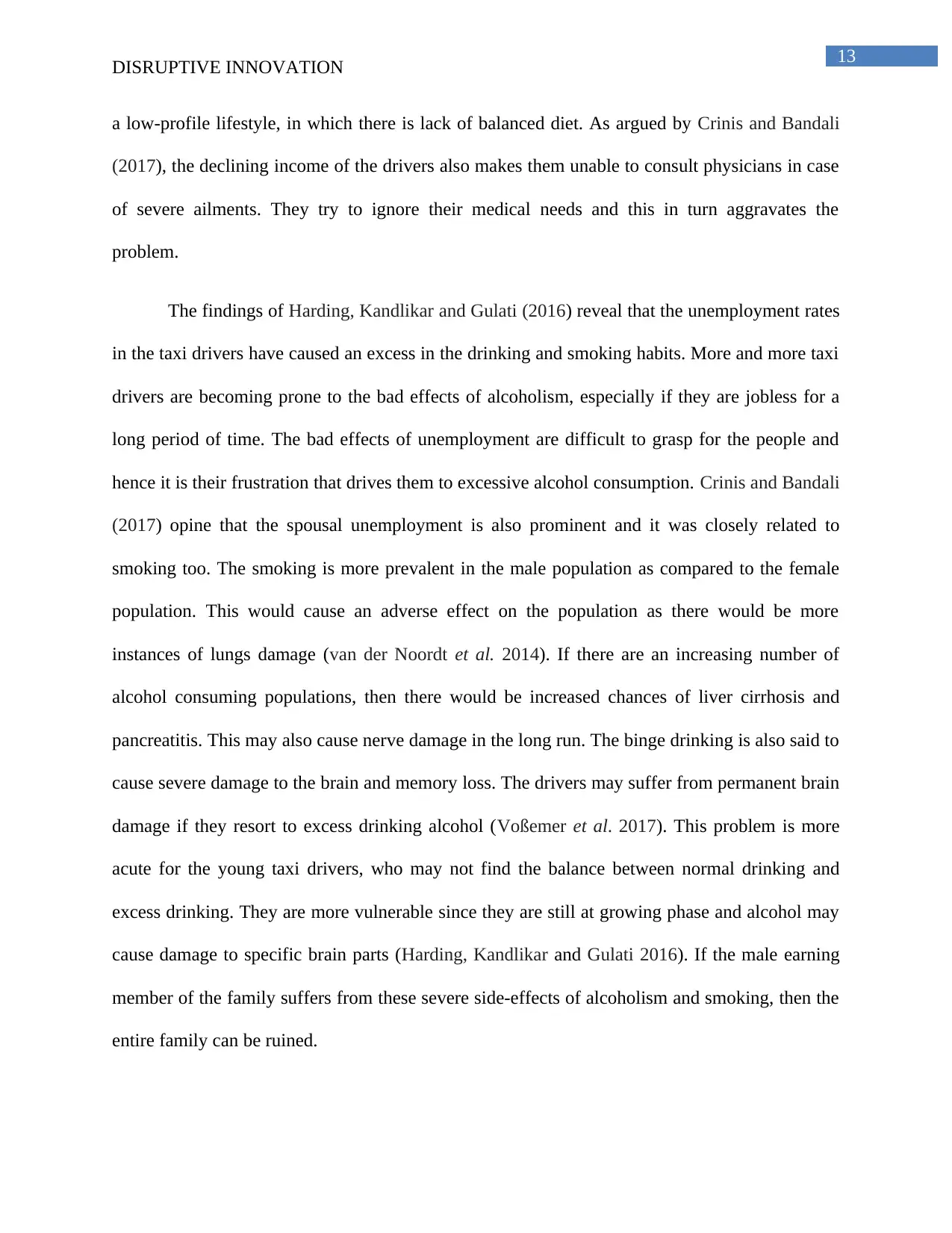
13
DISRUPTIVE INNOVATION
a low-profile lifestyle, in which there is lack of balanced diet. As argued by Crinis and Bandali
(2017), the declining income of the drivers also makes them unable to consult physicians in case
of severe ailments. They try to ignore their medical needs and this in turn aggravates the
problem.
The findings of Harding, Kandlikar and Gulati (2016) reveal that the unemployment rates
in the taxi drivers have caused an excess in the drinking and smoking habits. More and more taxi
drivers are becoming prone to the bad effects of alcoholism, especially if they are jobless for a
long period of time. The bad effects of unemployment are difficult to grasp for the people and
hence it is their frustration that drives them to excessive alcohol consumption. Crinis and Bandali
(2017) opine that the spousal unemployment is also prominent and it was closely related to
smoking too. The smoking is more prevalent in the male population as compared to the female
population. This would cause an adverse effect on the population as there would be more
instances of lungs damage (van der Noordt et al. 2014). If there are an increasing number of
alcohol consuming populations, then there would be increased chances of liver cirrhosis and
pancreatitis. This may also cause nerve damage in the long run. The binge drinking is also said to
cause severe damage to the brain and memory loss. The drivers may suffer from permanent brain
damage if they resort to excess drinking alcohol (Voßemer et al. 2017). This problem is more
acute for the young taxi drivers, who may not find the balance between normal drinking and
excess drinking. They are more vulnerable since they are still at growing phase and alcohol may
cause damage to specific brain parts (Harding, Kandlikar and Gulati 2016). If the male earning
member of the family suffers from these severe side-effects of alcoholism and smoking, then the
entire family can be ruined.
DISRUPTIVE INNOVATION
a low-profile lifestyle, in which there is lack of balanced diet. As argued by Crinis and Bandali
(2017), the declining income of the drivers also makes them unable to consult physicians in case
of severe ailments. They try to ignore their medical needs and this in turn aggravates the
problem.
The findings of Harding, Kandlikar and Gulati (2016) reveal that the unemployment rates
in the taxi drivers have caused an excess in the drinking and smoking habits. More and more taxi
drivers are becoming prone to the bad effects of alcoholism, especially if they are jobless for a
long period of time. The bad effects of unemployment are difficult to grasp for the people and
hence it is their frustration that drives them to excessive alcohol consumption. Crinis and Bandali
(2017) opine that the spousal unemployment is also prominent and it was closely related to
smoking too. The smoking is more prevalent in the male population as compared to the female
population. This would cause an adverse effect on the population as there would be more
instances of lungs damage (van der Noordt et al. 2014). If there are an increasing number of
alcohol consuming populations, then there would be increased chances of liver cirrhosis and
pancreatitis. This may also cause nerve damage in the long run. The binge drinking is also said to
cause severe damage to the brain and memory loss. The drivers may suffer from permanent brain
damage if they resort to excess drinking alcohol (Voßemer et al. 2017). This problem is more
acute for the young taxi drivers, who may not find the balance between normal drinking and
excess drinking. They are more vulnerable since they are still at growing phase and alcohol may
cause damage to specific brain parts (Harding, Kandlikar and Gulati 2016). If the male earning
member of the family suffers from these severe side-effects of alcoholism and smoking, then the
entire family can be ruined.
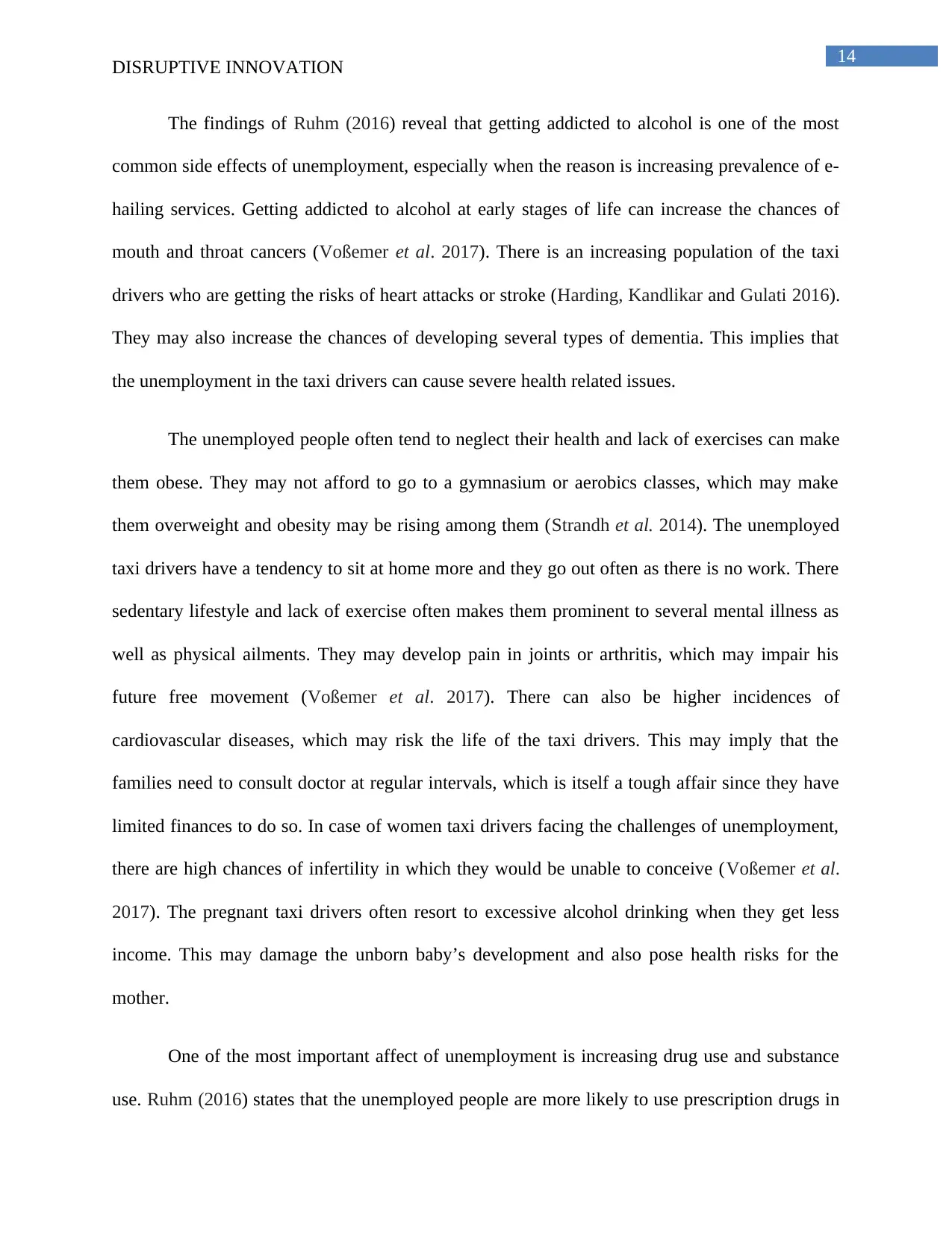
14
DISRUPTIVE INNOVATION
The findings of Ruhm (2016) reveal that getting addicted to alcohol is one of the most
common side effects of unemployment, especially when the reason is increasing prevalence of e-
hailing services. Getting addicted to alcohol at early stages of life can increase the chances of
mouth and throat cancers (Voßemer et al. 2017). There is an increasing population of the taxi
drivers who are getting the risks of heart attacks or stroke (Harding, Kandlikar and Gulati 2016).
They may also increase the chances of developing several types of dementia. This implies that
the unemployment in the taxi drivers can cause severe health related issues.
The unemployed people often tend to neglect their health and lack of exercises can make
them obese. They may not afford to go to a gymnasium or aerobics classes, which may make
them overweight and obesity may be rising among them (Strandh et al. 2014). The unemployed
taxi drivers have a tendency to sit at home more and they go out often as there is no work. There
sedentary lifestyle and lack of exercise often makes them prominent to several mental illness as
well as physical ailments. They may develop pain in joints or arthritis, which may impair his
future free movement (Voßemer et al. 2017). There can also be higher incidences of
cardiovascular diseases, which may risk the life of the taxi drivers. This may imply that the
families need to consult doctor at regular intervals, which is itself a tough affair since they have
limited finances to do so. In case of women taxi drivers facing the challenges of unemployment,
there are high chances of infertility in which they would be unable to conceive (Voßemer et al.
2017). The pregnant taxi drivers often resort to excessive alcohol drinking when they get less
income. This may damage the unborn baby’s development and also pose health risks for the
mother.
One of the most important affect of unemployment is increasing drug use and substance
use. Ruhm (2016) states that the unemployed people are more likely to use prescription drugs in
DISRUPTIVE INNOVATION
The findings of Ruhm (2016) reveal that getting addicted to alcohol is one of the most
common side effects of unemployment, especially when the reason is increasing prevalence of e-
hailing services. Getting addicted to alcohol at early stages of life can increase the chances of
mouth and throat cancers (Voßemer et al. 2017). There is an increasing population of the taxi
drivers who are getting the risks of heart attacks or stroke (Harding, Kandlikar and Gulati 2016).
They may also increase the chances of developing several types of dementia. This implies that
the unemployment in the taxi drivers can cause severe health related issues.
The unemployed people often tend to neglect their health and lack of exercises can make
them obese. They may not afford to go to a gymnasium or aerobics classes, which may make
them overweight and obesity may be rising among them (Strandh et al. 2014). The unemployed
taxi drivers have a tendency to sit at home more and they go out often as there is no work. There
sedentary lifestyle and lack of exercise often makes them prominent to several mental illness as
well as physical ailments. They may develop pain in joints or arthritis, which may impair his
future free movement (Voßemer et al. 2017). There can also be higher incidences of
cardiovascular diseases, which may risk the life of the taxi drivers. This may imply that the
families need to consult doctor at regular intervals, which is itself a tough affair since they have
limited finances to do so. In case of women taxi drivers facing the challenges of unemployment,
there are high chances of infertility in which they would be unable to conceive (Voßemer et al.
2017). The pregnant taxi drivers often resort to excessive alcohol drinking when they get less
income. This may damage the unborn baby’s development and also pose health risks for the
mother.
One of the most important affect of unemployment is increasing drug use and substance
use. Ruhm (2016) states that the unemployed people are more likely to use prescription drugs in
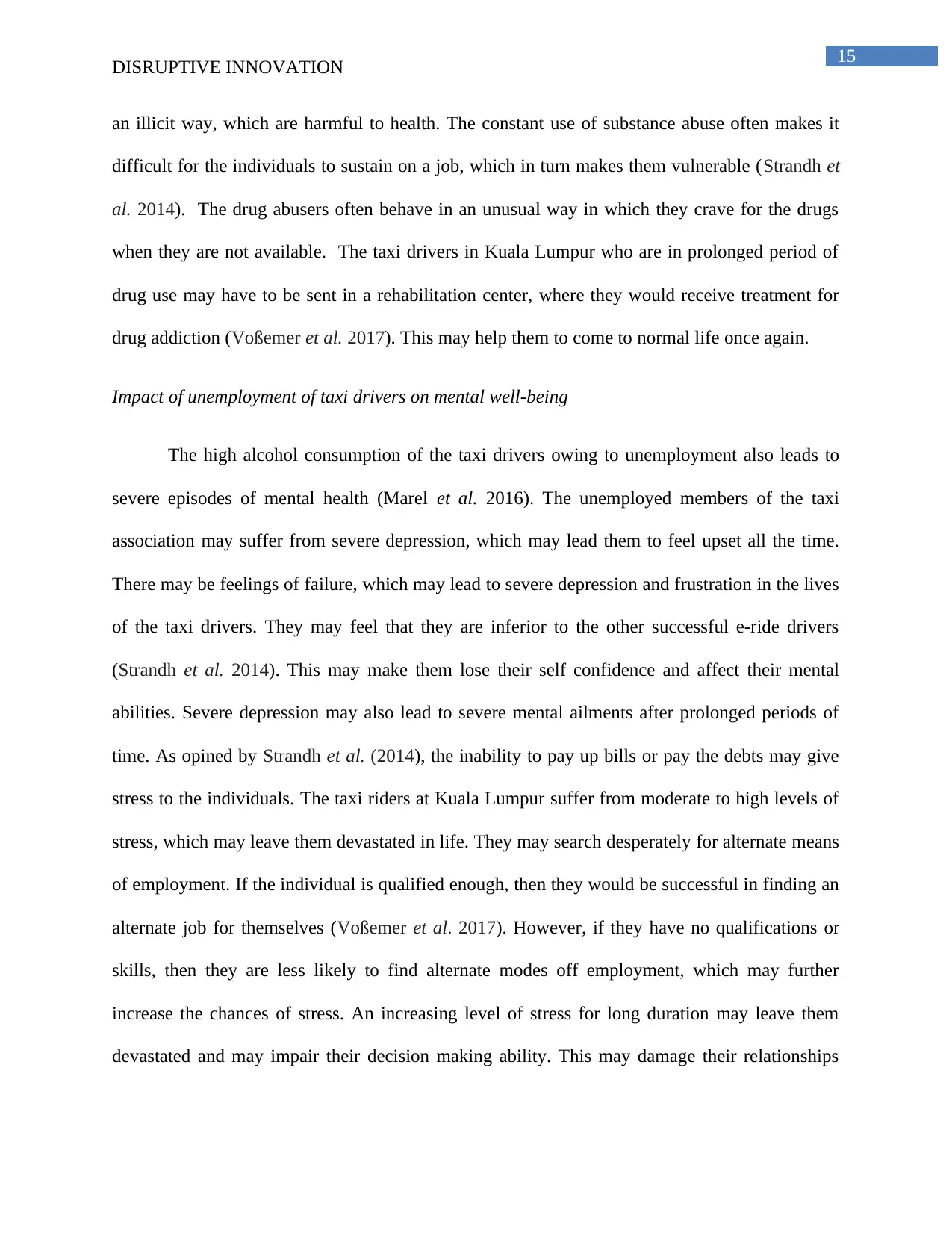
15
DISRUPTIVE INNOVATION
an illicit way, which are harmful to health. The constant use of substance abuse often makes it
difficult for the individuals to sustain on a job, which in turn makes them vulnerable (Strandh et
al. 2014). The drug abusers often behave in an unusual way in which they crave for the drugs
when they are not available. The taxi drivers in Kuala Lumpur who are in prolonged period of
drug use may have to be sent in a rehabilitation center, where they would receive treatment for
drug addiction (Voßemer et al. 2017). This may help them to come to normal life once again.
Impact of unemployment of taxi drivers on mental well-being
The high alcohol consumption of the taxi drivers owing to unemployment also leads to
severe episodes of mental health (Marel et al. 2016). The unemployed members of the taxi
association may suffer from severe depression, which may lead them to feel upset all the time.
There may be feelings of failure, which may lead to severe depression and frustration in the lives
of the taxi drivers. They may feel that they are inferior to the other successful e-ride drivers
(Strandh et al. 2014). This may make them lose their self confidence and affect their mental
abilities. Severe depression may also lead to severe mental ailments after prolonged periods of
time. As opined by Strandh et al. (2014), the inability to pay up bills or pay the debts may give
stress to the individuals. The taxi riders at Kuala Lumpur suffer from moderate to high levels of
stress, which may leave them devastated in life. They may search desperately for alternate means
of employment. If the individual is qualified enough, then they would be successful in finding an
alternate job for themselves (Voßemer et al. 2017). However, if they have no qualifications or
skills, then they are less likely to find alternate modes off employment, which may further
increase the chances of stress. An increasing level of stress for long duration may leave them
devastated and may impair their decision making ability. This may damage their relationships
DISRUPTIVE INNOVATION
an illicit way, which are harmful to health. The constant use of substance abuse often makes it
difficult for the individuals to sustain on a job, which in turn makes them vulnerable (Strandh et
al. 2014). The drug abusers often behave in an unusual way in which they crave for the drugs
when they are not available. The taxi drivers in Kuala Lumpur who are in prolonged period of
drug use may have to be sent in a rehabilitation center, where they would receive treatment for
drug addiction (Voßemer et al. 2017). This may help them to come to normal life once again.
Impact of unemployment of taxi drivers on mental well-being
The high alcohol consumption of the taxi drivers owing to unemployment also leads to
severe episodes of mental health (Marel et al. 2016). The unemployed members of the taxi
association may suffer from severe depression, which may lead them to feel upset all the time.
There may be feelings of failure, which may lead to severe depression and frustration in the lives
of the taxi drivers. They may feel that they are inferior to the other successful e-ride drivers
(Strandh et al. 2014). This may make them lose their self confidence and affect their mental
abilities. Severe depression may also lead to severe mental ailments after prolonged periods of
time. As opined by Strandh et al. (2014), the inability to pay up bills or pay the debts may give
stress to the individuals. The taxi riders at Kuala Lumpur suffer from moderate to high levels of
stress, which may leave them devastated in life. They may search desperately for alternate means
of employment. If the individual is qualified enough, then they would be successful in finding an
alternate job for themselves (Voßemer et al. 2017). However, if they have no qualifications or
skills, then they are less likely to find alternate modes off employment, which may further
increase the chances of stress. An increasing level of stress for long duration may leave them
devastated and may impair their decision making ability. This may damage their relationships
Secure Best Marks with AI Grader
Need help grading? Try our AI Grader for instant feedback on your assignments.

16
DISRUPTIVE INNOVATION
with near and dear ones (Harding, Kandlikar and Gulati 2016). In case they are students, they
would find it difficult to concentrate on their studies.
The high level of unemployment among taxi drivers due to the e-hailing services may
push them towards loneliness or isolation. As per the discussions of Fergusson, McLeod and
Horwood (2014), the human beings are social beings, who if left out of job may risk the chance
of having isolated life. This has severe side-effects on the mental well-being of the individuals.
This may lower the self-esteem of the individuals as they remain out of work. It is said that one’s
work gives one confidence in his personal as well as professional life (Harding, Kandlikar and
Gulati 2016). The work of the taxi drivers gives them a sense of satisfaction, joy and belonging.
If there is no work, then they would feel that they have nothing to contribute to the community.
The person starts to feel themselves useless as there are no work opportunities (Modini et al.
2016). The feeling of unemployment makes the person worthless and if there are no
qualifications, then it further worsens the feelings. When the taxi driver would see that the e-hail
drivers are earning more than them, then they would automatically enter phases of depression in
which it becomes difficult to concentrate on anything (Fergusson, McLeod and Horwood 2014).
The severe episodes of depression may lead them suicidal tendencies, where they may feel that it
is best to end up their lives. The act of unemployment is said to psychologically destructive and
there is great degree of shocks especially during the initial phases (Modini et al. 2016). The
severe suicidal tendencies have negative effect not only on the individuals but they also affect
the family members of the concerned persons (Modini et al. 2016). The unemployed persons for
long time may find different ways to end up their lives and if they are unsuccessful at them, it
may further increase their depression levels. The drug users may also have psychological
DISRUPTIVE INNOVATION
with near and dear ones (Harding, Kandlikar and Gulati 2016). In case they are students, they
would find it difficult to concentrate on their studies.
The high level of unemployment among taxi drivers due to the e-hailing services may
push them towards loneliness or isolation. As per the discussions of Fergusson, McLeod and
Horwood (2014), the human beings are social beings, who if left out of job may risk the chance
of having isolated life. This has severe side-effects on the mental well-being of the individuals.
This may lower the self-esteem of the individuals as they remain out of work. It is said that one’s
work gives one confidence in his personal as well as professional life (Harding, Kandlikar and
Gulati 2016). The work of the taxi drivers gives them a sense of satisfaction, joy and belonging.
If there is no work, then they would feel that they have nothing to contribute to the community.
The person starts to feel themselves useless as there are no work opportunities (Modini et al.
2016). The feeling of unemployment makes the person worthless and if there are no
qualifications, then it further worsens the feelings. When the taxi driver would see that the e-hail
drivers are earning more than them, then they would automatically enter phases of depression in
which it becomes difficult to concentrate on anything (Fergusson, McLeod and Horwood 2014).
The severe episodes of depression may lead them suicidal tendencies, where they may feel that it
is best to end up their lives. The act of unemployment is said to psychologically destructive and
there is great degree of shocks especially during the initial phases (Modini et al. 2016). The
severe suicidal tendencies have negative effect not only on the individuals but they also affect
the family members of the concerned persons (Modini et al. 2016). The unemployed persons for
long time may find different ways to end up their lives and if they are unsuccessful at them, it
may further increase their depression levels. The drug users may also have psychological
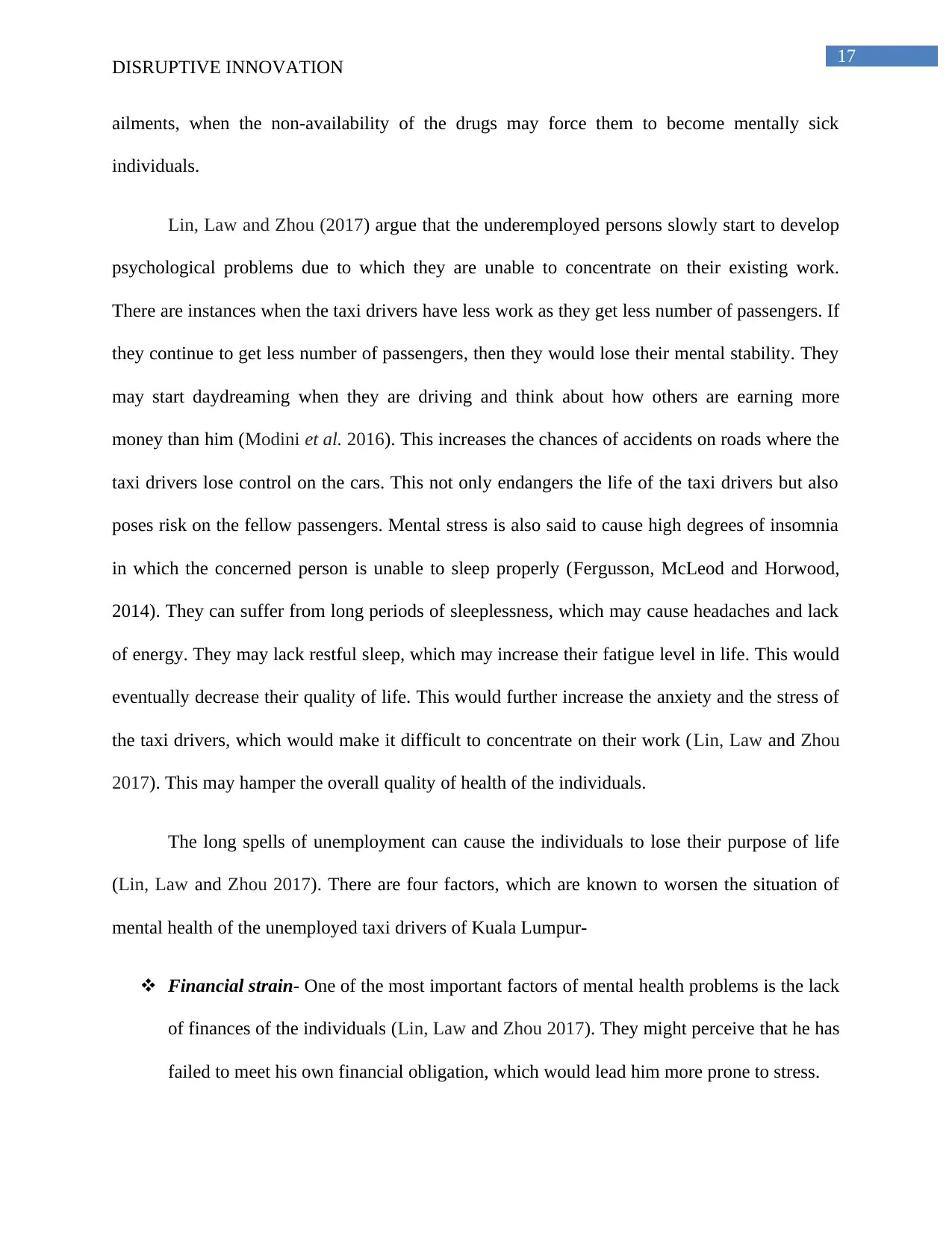
17
DISRUPTIVE INNOVATION
ailments, when the non-availability of the drugs may force them to become mentally sick
individuals.
Lin, Law and Zhou (2017) argue that the underemployed persons slowly start to develop
psychological problems due to which they are unable to concentrate on their existing work.
There are instances when the taxi drivers have less work as they get less number of passengers. If
they continue to get less number of passengers, then they would lose their mental stability. They
may start daydreaming when they are driving and think about how others are earning more
money than him (Modini et al. 2016). This increases the chances of accidents on roads where the
taxi drivers lose control on the cars. This not only endangers the life of the taxi drivers but also
poses risk on the fellow passengers. Mental stress is also said to cause high degrees of insomnia
in which the concerned person is unable to sleep properly (Fergusson, McLeod and Horwood,
2014). They can suffer from long periods of sleeplessness, which may cause headaches and lack
of energy. They may lack restful sleep, which may increase their fatigue level in life. This would
eventually decrease their quality of life. This would further increase the anxiety and the stress of
the taxi drivers, which would make it difficult to concentrate on their work (Lin, Law and Zhou
2017). This may hamper the overall quality of health of the individuals.
The long spells of unemployment can cause the individuals to lose their purpose of life
(Lin, Law and Zhou 2017). There are four factors, which are known to worsen the situation of
mental health of the unemployed taxi drivers of Kuala Lumpur-
Financial strain- One of the most important factors of mental health problems is the lack
of finances of the individuals (Lin, Law and Zhou 2017). They might perceive that he has
failed to meet his own financial obligation, which would lead him more prone to stress.
DISRUPTIVE INNOVATION
ailments, when the non-availability of the drugs may force them to become mentally sick
individuals.
Lin, Law and Zhou (2017) argue that the underemployed persons slowly start to develop
psychological problems due to which they are unable to concentrate on their existing work.
There are instances when the taxi drivers have less work as they get less number of passengers. If
they continue to get less number of passengers, then they would lose their mental stability. They
may start daydreaming when they are driving and think about how others are earning more
money than him (Modini et al. 2016). This increases the chances of accidents on roads where the
taxi drivers lose control on the cars. This not only endangers the life of the taxi drivers but also
poses risk on the fellow passengers. Mental stress is also said to cause high degrees of insomnia
in which the concerned person is unable to sleep properly (Fergusson, McLeod and Horwood,
2014). They can suffer from long periods of sleeplessness, which may cause headaches and lack
of energy. They may lack restful sleep, which may increase their fatigue level in life. This would
eventually decrease their quality of life. This would further increase the anxiety and the stress of
the taxi drivers, which would make it difficult to concentrate on their work (Lin, Law and Zhou
2017). This may hamper the overall quality of health of the individuals.
The long spells of unemployment can cause the individuals to lose their purpose of life
(Lin, Law and Zhou 2017). There are four factors, which are known to worsen the situation of
mental health of the unemployed taxi drivers of Kuala Lumpur-
Financial strain- One of the most important factors of mental health problems is the lack
of finances of the individuals (Lin, Law and Zhou 2017). They might perceive that he has
failed to meet his own financial obligation, which would lead him more prone to stress.
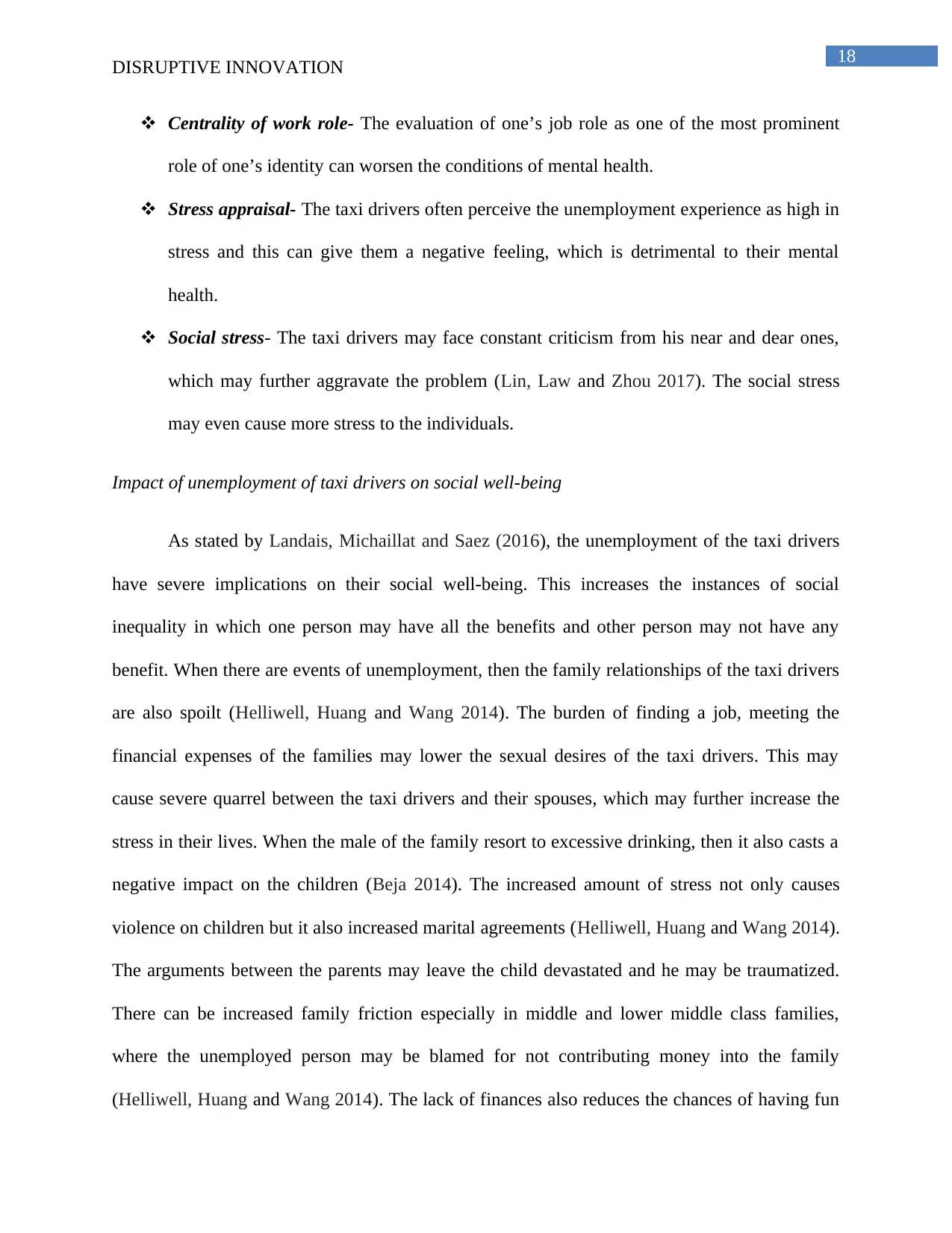
18
DISRUPTIVE INNOVATION
Centrality of work role- The evaluation of one’s job role as one of the most prominent
role of one’s identity can worsen the conditions of mental health.
Stress appraisal- The taxi drivers often perceive the unemployment experience as high in
stress and this can give them a negative feeling, which is detrimental to their mental
health.
Social stress- The taxi drivers may face constant criticism from his near and dear ones,
which may further aggravate the problem (Lin, Law and Zhou 2017). The social stress
may even cause more stress to the individuals.
Impact of unemployment of taxi drivers on social well-being
As stated by Landais, Michaillat and Saez (2016), the unemployment of the taxi drivers
have severe implications on their social well-being. This increases the instances of social
inequality in which one person may have all the benefits and other person may not have any
benefit. When there are events of unemployment, then the family relationships of the taxi drivers
are also spoilt (Helliwell, Huang and Wang 2014). The burden of finding a job, meeting the
financial expenses of the families may lower the sexual desires of the taxi drivers. This may
cause severe quarrel between the taxi drivers and their spouses, which may further increase the
stress in their lives. When the male of the family resort to excessive drinking, then it also casts a
negative impact on the children (Beja 2014). The increased amount of stress not only causes
violence on children but it also increased marital agreements (Helliwell, Huang and Wang 2014).
The arguments between the parents may leave the child devastated and he may be traumatized.
There can be increased family friction especially in middle and lower middle class families,
where the unemployed person may be blamed for not contributing money into the family
(Helliwell, Huang and Wang 2014). The lack of finances also reduces the chances of having fun
DISRUPTIVE INNOVATION
Centrality of work role- The evaluation of one’s job role as one of the most prominent
role of one’s identity can worsen the conditions of mental health.
Stress appraisal- The taxi drivers often perceive the unemployment experience as high in
stress and this can give them a negative feeling, which is detrimental to their mental
health.
Social stress- The taxi drivers may face constant criticism from his near and dear ones,
which may further aggravate the problem (Lin, Law and Zhou 2017). The social stress
may even cause more stress to the individuals.
Impact of unemployment of taxi drivers on social well-being
As stated by Landais, Michaillat and Saez (2016), the unemployment of the taxi drivers
have severe implications on their social well-being. This increases the instances of social
inequality in which one person may have all the benefits and other person may not have any
benefit. When there are events of unemployment, then the family relationships of the taxi drivers
are also spoilt (Helliwell, Huang and Wang 2014). The burden of finding a job, meeting the
financial expenses of the families may lower the sexual desires of the taxi drivers. This may
cause severe quarrel between the taxi drivers and their spouses, which may further increase the
stress in their lives. When the male of the family resort to excessive drinking, then it also casts a
negative impact on the children (Beja 2014). The increased amount of stress not only causes
violence on children but it also increased marital agreements (Helliwell, Huang and Wang 2014).
The arguments between the parents may leave the child devastated and he may be traumatized.
There can be increased family friction especially in middle and lower middle class families,
where the unemployed person may be blamed for not contributing money into the family
(Helliwell, Huang and Wang 2014). The lack of finances also reduces the chances of having fun
Paraphrase This Document
Need a fresh take? Get an instant paraphrase of this document with our AI Paraphraser
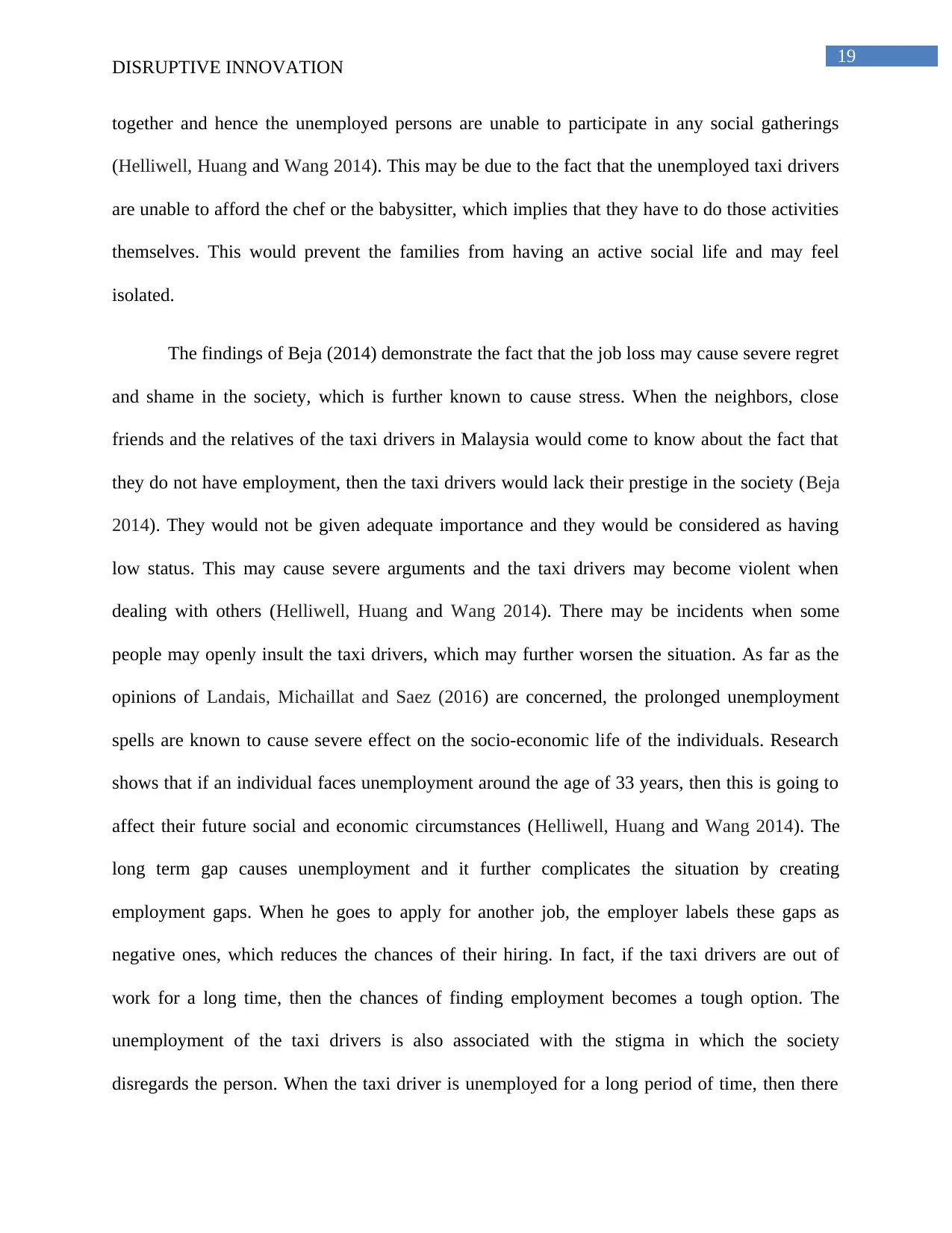
19
DISRUPTIVE INNOVATION
together and hence the unemployed persons are unable to participate in any social gatherings
(Helliwell, Huang and Wang 2014). This may be due to the fact that the unemployed taxi drivers
are unable to afford the chef or the babysitter, which implies that they have to do those activities
themselves. This would prevent the families from having an active social life and may feel
isolated.
The findings of Beja (2014) demonstrate the fact that the job loss may cause severe regret
and shame in the society, which is further known to cause stress. When the neighbors, close
friends and the relatives of the taxi drivers in Malaysia would come to know about the fact that
they do not have employment, then the taxi drivers would lack their prestige in the society (Beja
2014). They would not be given adequate importance and they would be considered as having
low status. This may cause severe arguments and the taxi drivers may become violent when
dealing with others (Helliwell, Huang and Wang 2014). There may be incidents when some
people may openly insult the taxi drivers, which may further worsen the situation. As far as the
opinions of Landais, Michaillat and Saez (2016) are concerned, the prolonged unemployment
spells are known to cause severe effect on the socio-economic life of the individuals. Research
shows that if an individual faces unemployment around the age of 33 years, then this is going to
affect their future social and economic circumstances (Helliwell, Huang and Wang 2014). The
long term gap causes unemployment and it further complicates the situation by creating
employment gaps. When he goes to apply for another job, the employer labels these gaps as
negative ones, which reduces the chances of their hiring. In fact, if the taxi drivers are out of
work for a long time, then the chances of finding employment becomes a tough option. The
unemployment of the taxi drivers is also associated with the stigma in which the society
disregards the person. When the taxi driver is unemployed for a long period of time, then there
DISRUPTIVE INNOVATION
together and hence the unemployed persons are unable to participate in any social gatherings
(Helliwell, Huang and Wang 2014). This may be due to the fact that the unemployed taxi drivers
are unable to afford the chef or the babysitter, which implies that they have to do those activities
themselves. This would prevent the families from having an active social life and may feel
isolated.
The findings of Beja (2014) demonstrate the fact that the job loss may cause severe regret
and shame in the society, which is further known to cause stress. When the neighbors, close
friends and the relatives of the taxi drivers in Malaysia would come to know about the fact that
they do not have employment, then the taxi drivers would lack their prestige in the society (Beja
2014). They would not be given adequate importance and they would be considered as having
low status. This may cause severe arguments and the taxi drivers may become violent when
dealing with others (Helliwell, Huang and Wang 2014). There may be incidents when some
people may openly insult the taxi drivers, which may further worsen the situation. As far as the
opinions of Landais, Michaillat and Saez (2016) are concerned, the prolonged unemployment
spells are known to cause severe effect on the socio-economic life of the individuals. Research
shows that if an individual faces unemployment around the age of 33 years, then this is going to
affect their future social and economic circumstances (Helliwell, Huang and Wang 2014). The
long term gap causes unemployment and it further complicates the situation by creating
employment gaps. When he goes to apply for another job, the employer labels these gaps as
negative ones, which reduces the chances of their hiring. In fact, if the taxi drivers are out of
work for a long time, then the chances of finding employment becomes a tough option. The
unemployment of the taxi drivers is also associated with the stigma in which the society
disregards the person. When the taxi driver is unemployed for a long period of time, then there

20
DISRUPTIVE INNOVATION
are chances that he may be disregarded in the society. This not only affects the social status of
the taxi drivers, but it also affects the mental composition.
It can be concluded that e-hailing services is causing a major affect on the unemployment
of the traditional taxi services, which is causing all round effect on their lives. More and more
taxi drivers are losing their employment due to the increase in the e-ride applications. This is
affecting the mental, physical, financial and social well-being of the taxi drivers, which is
becoming a rising issue. It is important to address this issue with care and proper planning, so
that the future of the taxi drivers is secured.
DISRUPTIVE INNOVATION
are chances that he may be disregarded in the society. This not only affects the social status of
the taxi drivers, but it also affects the mental composition.
It can be concluded that e-hailing services is causing a major affect on the unemployment
of the traditional taxi services, which is causing all round effect on their lives. More and more
taxi drivers are losing their employment due to the increase in the e-ride applications. This is
affecting the mental, physical, financial and social well-being of the taxi drivers, which is
becoming a rising issue. It is important to address this issue with care and proper planning, so
that the future of the taxi drivers is secured.
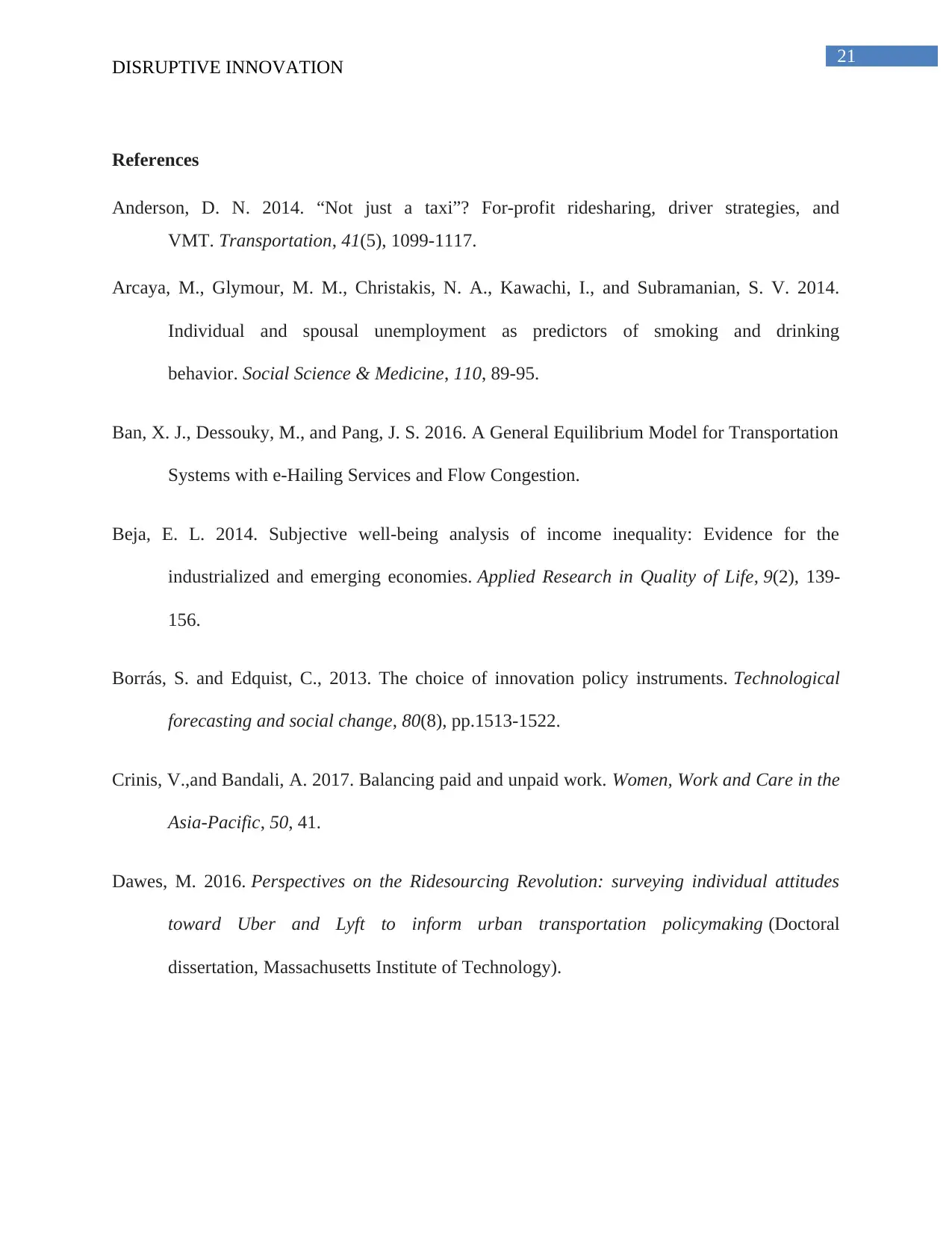
21
DISRUPTIVE INNOVATION
References
Anderson, D. N. 2014. “Not just a taxi”? For-profit ridesharing, driver strategies, and
VMT. Transportation, 41(5), 1099-1117.
Arcaya, M., Glymour, M. M., Christakis, N. A., Kawachi, I., and Subramanian, S. V. 2014.
Individual and spousal unemployment as predictors of smoking and drinking
behavior. Social Science & Medicine, 110, 89-95.
Ban, X. J., Dessouky, M., and Pang, J. S. 2016. A General Equilibrium Model for Transportation
Systems with e-Hailing Services and Flow Congestion.
Beja, E. L. 2014. Subjective well-being analysis of income inequality: Evidence for the
industrialized and emerging economies. Applied Research in Quality of Life, 9(2), 139-
156.
Borrás, S. and Edquist, C., 2013. The choice of innovation policy instruments. Technological
forecasting and social change, 80(8), pp.1513-1522.
Crinis, V.,and Bandali, A. 2017. Balancing paid and unpaid work. Women, Work and Care in the
Asia-Pacific, 50, 41.
Dawes, M. 2016. Perspectives on the Ridesourcing Revolution: surveying individual attitudes
toward Uber and Lyft to inform urban transportation policymaking (Doctoral
dissertation, Massachusetts Institute of Technology).
DISRUPTIVE INNOVATION
References
Anderson, D. N. 2014. “Not just a taxi”? For-profit ridesharing, driver strategies, and
VMT. Transportation, 41(5), 1099-1117.
Arcaya, M., Glymour, M. M., Christakis, N. A., Kawachi, I., and Subramanian, S. V. 2014.
Individual and spousal unemployment as predictors of smoking and drinking
behavior. Social Science & Medicine, 110, 89-95.
Ban, X. J., Dessouky, M., and Pang, J. S. 2016. A General Equilibrium Model for Transportation
Systems with e-Hailing Services and Flow Congestion.
Beja, E. L. 2014. Subjective well-being analysis of income inequality: Evidence for the
industrialized and emerging economies. Applied Research in Quality of Life, 9(2), 139-
156.
Borrás, S. and Edquist, C., 2013. The choice of innovation policy instruments. Technological
forecasting and social change, 80(8), pp.1513-1522.
Crinis, V.,and Bandali, A. 2017. Balancing paid and unpaid work. Women, Work and Care in the
Asia-Pacific, 50, 41.
Dawes, M. 2016. Perspectives on the Ridesourcing Revolution: surveying individual attitudes
toward Uber and Lyft to inform urban transportation policymaking (Doctoral
dissertation, Massachusetts Institute of Technology).
Secure Best Marks with AI Grader
Need help grading? Try our AI Grader for instant feedback on your assignments.
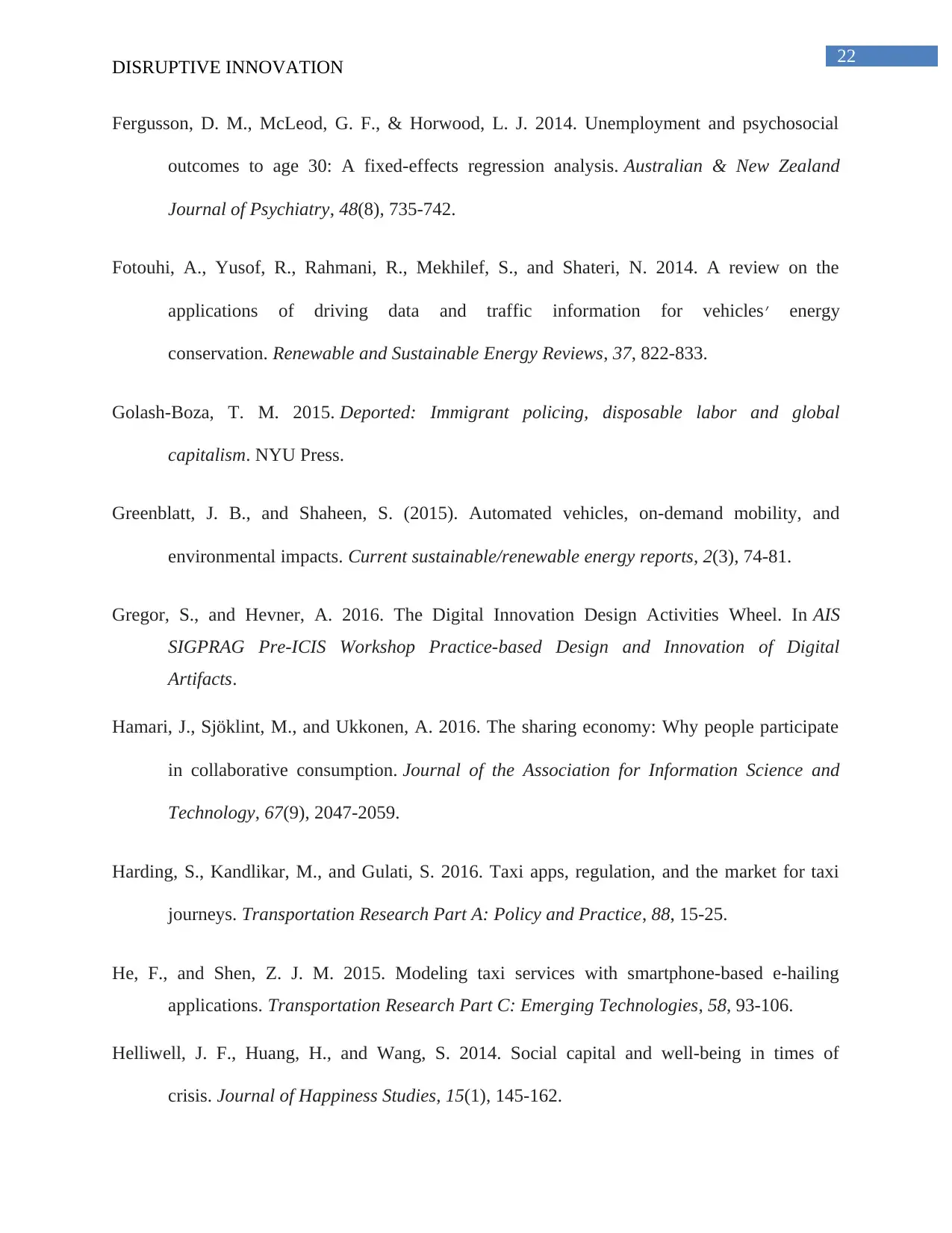
22
DISRUPTIVE INNOVATION
Fergusson, D. M., McLeod, G. F., & Horwood, L. J. 2014. Unemployment and psychosocial
outcomes to age 30: A fixed-effects regression analysis. Australian & New Zealand
Journal of Psychiatry, 48(8), 735-742.
Fotouhi, A., Yusof, R., Rahmani, R., Mekhilef, S., and Shateri, N. 2014. A review on the
applications of driving data and traffic information for vehicles׳ energy
conservation. Renewable and Sustainable Energy Reviews, 37, 822-833.
Golash-Boza, T. M. 2015. Deported: Immigrant policing, disposable labor and global
capitalism. NYU Press.
Greenblatt, J. B., and Shaheen, S. (2015). Automated vehicles, on-demand mobility, and
environmental impacts. Current sustainable/renewable energy reports, 2(3), 74-81.
Gregor, S., and Hevner, A. 2016. The Digital Innovation Design Activities Wheel. In AIS
SIGPRAG Pre-ICIS Workshop Practice-based Design and Innovation of Digital
Artifacts.
Hamari, J., Sjöklint, M., and Ukkonen, A. 2016. The sharing economy: Why people participate
in collaborative consumption. Journal of the Association for Information Science and
Technology, 67(9), 2047-2059.
Harding, S., Kandlikar, M., and Gulati, S. 2016. Taxi apps, regulation, and the market for taxi
journeys. Transportation Research Part A: Policy and Practice, 88, 15-25.
He, F., and Shen, Z. J. M. 2015. Modeling taxi services with smartphone-based e-hailing
applications. Transportation Research Part C: Emerging Technologies, 58, 93-106.
Helliwell, J. F., Huang, H., and Wang, S. 2014. Social capital and well-being in times of
crisis. Journal of Happiness Studies, 15(1), 145-162.
DISRUPTIVE INNOVATION
Fergusson, D. M., McLeod, G. F., & Horwood, L. J. 2014. Unemployment and psychosocial
outcomes to age 30: A fixed-effects regression analysis. Australian & New Zealand
Journal of Psychiatry, 48(8), 735-742.
Fotouhi, A., Yusof, R., Rahmani, R., Mekhilef, S., and Shateri, N. 2014. A review on the
applications of driving data and traffic information for vehicles׳ energy
conservation. Renewable and Sustainable Energy Reviews, 37, 822-833.
Golash-Boza, T. M. 2015. Deported: Immigrant policing, disposable labor and global
capitalism. NYU Press.
Greenblatt, J. B., and Shaheen, S. (2015). Automated vehicles, on-demand mobility, and
environmental impacts. Current sustainable/renewable energy reports, 2(3), 74-81.
Gregor, S., and Hevner, A. 2016. The Digital Innovation Design Activities Wheel. In AIS
SIGPRAG Pre-ICIS Workshop Practice-based Design and Innovation of Digital
Artifacts.
Hamari, J., Sjöklint, M., and Ukkonen, A. 2016. The sharing economy: Why people participate
in collaborative consumption. Journal of the Association for Information Science and
Technology, 67(9), 2047-2059.
Harding, S., Kandlikar, M., and Gulati, S. 2016. Taxi apps, regulation, and the market for taxi
journeys. Transportation Research Part A: Policy and Practice, 88, 15-25.
He, F., and Shen, Z. J. M. 2015. Modeling taxi services with smartphone-based e-hailing
applications. Transportation Research Part C: Emerging Technologies, 58, 93-106.
Helliwell, J. F., Huang, H., and Wang, S. 2014. Social capital and well-being in times of
crisis. Journal of Happiness Studies, 15(1), 145-162.
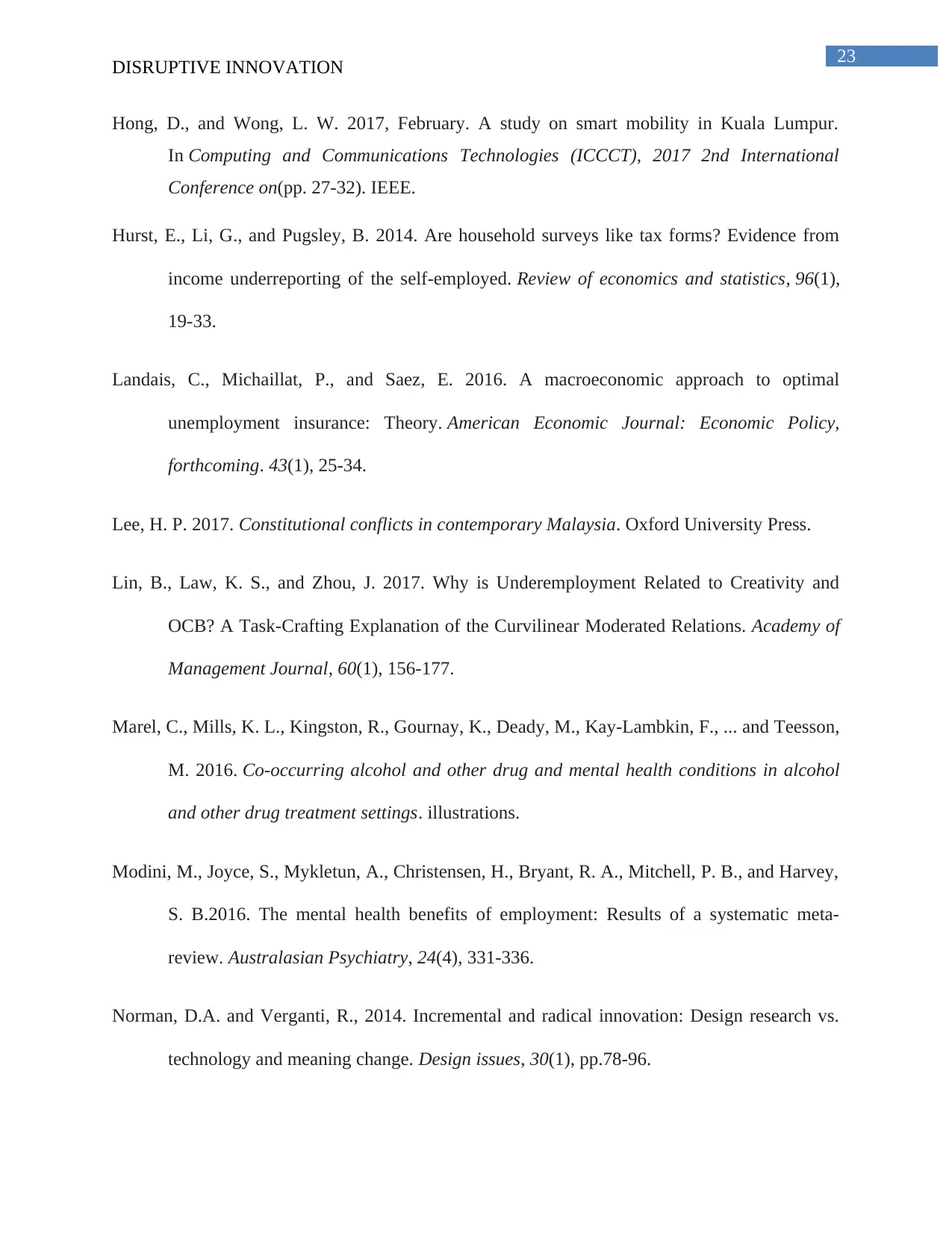
23
DISRUPTIVE INNOVATION
Hong, D., and Wong, L. W. 2017, February. A study on smart mobility in Kuala Lumpur.
In Computing and Communications Technologies (ICCCT), 2017 2nd International
Conference on(pp. 27-32). IEEE.
Hurst, E., Li, G., and Pugsley, B. 2014. Are household surveys like tax forms? Evidence from
income underreporting of the self-employed. Review of economics and statistics, 96(1),
19-33.
Landais, C., Michaillat, P., and Saez, E. 2016. A macroeconomic approach to optimal
unemployment insurance: Theory. American Economic Journal: Economic Policy,
forthcoming. 43(1), 25-34.
Lee, H. P. 2017. Constitutional conflicts in contemporary Malaysia. Oxford University Press.
Lin, B., Law, K. S., and Zhou, J. 2017. Why is Underemployment Related to Creativity and
OCB? A Task-Crafting Explanation of the Curvilinear Moderated Relations. Academy of
Management Journal, 60(1), 156-177.
Marel, C., Mills, K. L., Kingston, R., Gournay, K., Deady, M., Kay-Lambkin, F., ... and Teesson,
M. 2016. Co-occurring alcohol and other drug and mental health conditions in alcohol
and other drug treatment settings. illustrations.
Modini, M., Joyce, S., Mykletun, A., Christensen, H., Bryant, R. A., Mitchell, P. B., and Harvey,
S. B.2016. The mental health benefits of employment: Results of a systematic meta-
review. Australasian Psychiatry, 24(4), 331-336.
Norman, D.A. and Verganti, R., 2014. Incremental and radical innovation: Design research vs.
technology and meaning change. Design issues, 30(1), pp.78-96.
DISRUPTIVE INNOVATION
Hong, D., and Wong, L. W. 2017, February. A study on smart mobility in Kuala Lumpur.
In Computing and Communications Technologies (ICCCT), 2017 2nd International
Conference on(pp. 27-32). IEEE.
Hurst, E., Li, G., and Pugsley, B. 2014. Are household surveys like tax forms? Evidence from
income underreporting of the self-employed. Review of economics and statistics, 96(1),
19-33.
Landais, C., Michaillat, P., and Saez, E. 2016. A macroeconomic approach to optimal
unemployment insurance: Theory. American Economic Journal: Economic Policy,
forthcoming. 43(1), 25-34.
Lee, H. P. 2017. Constitutional conflicts in contemporary Malaysia. Oxford University Press.
Lin, B., Law, K. S., and Zhou, J. 2017. Why is Underemployment Related to Creativity and
OCB? A Task-Crafting Explanation of the Curvilinear Moderated Relations. Academy of
Management Journal, 60(1), 156-177.
Marel, C., Mills, K. L., Kingston, R., Gournay, K., Deady, M., Kay-Lambkin, F., ... and Teesson,
M. 2016. Co-occurring alcohol and other drug and mental health conditions in alcohol
and other drug treatment settings. illustrations.
Modini, M., Joyce, S., Mykletun, A., Christensen, H., Bryant, R. A., Mitchell, P. B., and Harvey,
S. B.2016. The mental health benefits of employment: Results of a systematic meta-
review. Australasian Psychiatry, 24(4), 331-336.
Norman, D.A. and Verganti, R., 2014. Incremental and radical innovation: Design research vs.
technology and meaning change. Design issues, 30(1), pp.78-96.
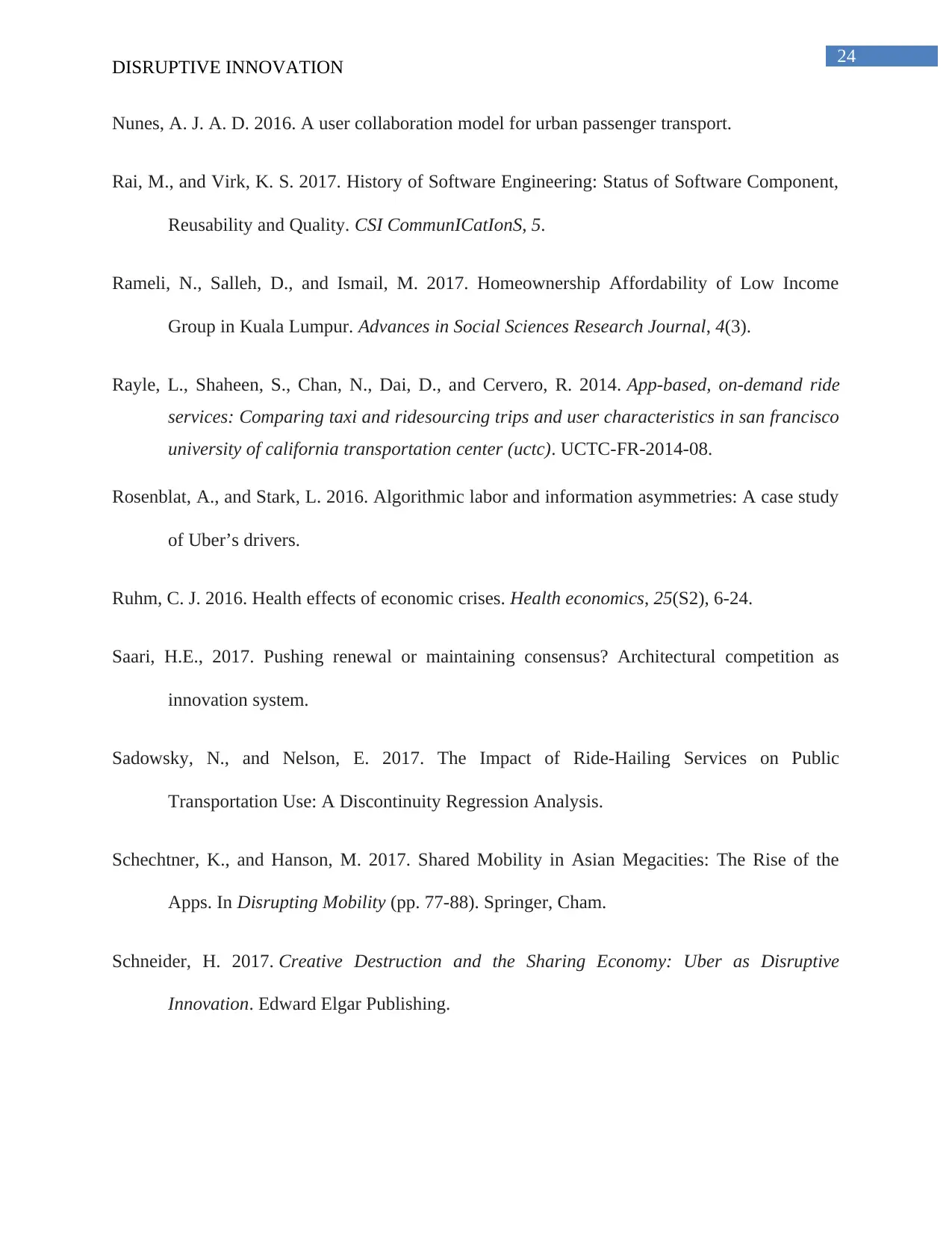
24
DISRUPTIVE INNOVATION
Nunes, A. J. A. D. 2016. A user collaboration model for urban passenger transport.
Rai, M., and Virk, K. S. 2017. History of Software Engineering: Status of Software Component,
Reusability and Quality. CSI CommunICatIonS, 5.
Rameli, N., Salleh, D., and Ismail, M. 2017. Homeownership Affordability of Low Income
Group in Kuala Lumpur. Advances in Social Sciences Research Journal, 4(3).
Rayle, L., Shaheen, S., Chan, N., Dai, D., and Cervero, R. 2014. App-based, on-demand ride
services: Comparing taxi and ridesourcing trips and user characteristics in san francisco
university of california transportation center (uctc). UCTC-FR-2014-08.
Rosenblat, A., and Stark, L. 2016. Algorithmic labor and information asymmetries: A case study
of Uber’s drivers.
Ruhm, C. J. 2016. Health effects of economic crises. Health economics, 25(S2), 6-24.
Saari, H.E., 2017. Pushing renewal or maintaining consensus? Architectural competition as
innovation system.
Sadowsky, N., and Nelson, E. 2017. The Impact of Ride-Hailing Services on Public
Transportation Use: A Discontinuity Regression Analysis.
Schechtner, K., and Hanson, M. 2017. Shared Mobility in Asian Megacities: The Rise of the
Apps. In Disrupting Mobility (pp. 77-88). Springer, Cham.
Schneider, H. 2017. Creative Destruction and the Sharing Economy: Uber as Disruptive
Innovation. Edward Elgar Publishing.
DISRUPTIVE INNOVATION
Nunes, A. J. A. D. 2016. A user collaboration model for urban passenger transport.
Rai, M., and Virk, K. S. 2017. History of Software Engineering: Status of Software Component,
Reusability and Quality. CSI CommunICatIonS, 5.
Rameli, N., Salleh, D., and Ismail, M. 2017. Homeownership Affordability of Low Income
Group in Kuala Lumpur. Advances in Social Sciences Research Journal, 4(3).
Rayle, L., Shaheen, S., Chan, N., Dai, D., and Cervero, R. 2014. App-based, on-demand ride
services: Comparing taxi and ridesourcing trips and user characteristics in san francisco
university of california transportation center (uctc). UCTC-FR-2014-08.
Rosenblat, A., and Stark, L. 2016. Algorithmic labor and information asymmetries: A case study
of Uber’s drivers.
Ruhm, C. J. 2016. Health effects of economic crises. Health economics, 25(S2), 6-24.
Saari, H.E., 2017. Pushing renewal or maintaining consensus? Architectural competition as
innovation system.
Sadowsky, N., and Nelson, E. 2017. The Impact of Ride-Hailing Services on Public
Transportation Use: A Discontinuity Regression Analysis.
Schechtner, K., and Hanson, M. 2017. Shared Mobility in Asian Megacities: The Rise of the
Apps. In Disrupting Mobility (pp. 77-88). Springer, Cham.
Schneider, H. 2017. Creative Destruction and the Sharing Economy: Uber as Disruptive
Innovation. Edward Elgar Publishing.
Paraphrase This Document
Need a fresh take? Get an instant paraphrase of this document with our AI Paraphraser

25
DISRUPTIVE INNOVATION
Strandh, M., Winefield, A., Nilsson, K., and Hammarström, A. 2014. Unemployment and mental
health scarring during the life course. The European Journal of Public Health, 24(3),
440-445.
van der Noordt, M., IJzelenberg, H., Droomers, M., and Proper, K. I. 2014. Health effects of
employment: a systematic review of prospective studies. Occup Environ Med, oemed-
2013.
Venkatesh, G., and Easaw, G. 2015. Measuring the Performance of Taxi Aggregator Service
Supply Chain. SAMVAD, 10, 26-36.
Voßemer, J., Gebel, M., Täht, K., Unt, M., Högberg, B., and Strandh, M. 2017. The effects of
unemployment and insecure jobs on well-being and health: the moderating role of labor
market policies. Social Indicators Research, 1-29.
Wallsten, S. 2015. The competitive effects of the sharing economy: how is Uber changing
taxis?. Technology Policy Institute, 22.
Westervelt, M., Schank, J., and Huang, E. 2017. Partnerships with Technology-Enabled Mobility
Companies: Lessons Learned. Transportation Research Record: Journal of the
Transportation Research Board, (2649), 106-112.
Wirtz, J., and Tang, C. 2016. Uber: Competing as market leader in the us versus being a distant
second in china. In SERVICES MARKETING: People Technology Strategy (pp. 626-632).
Woo, C. P., and Bales, R. A. 2016. The Uber Million Dollar Question: Are Uber Drivers
Employees or Independent Contractors?
Wyman, K. M. 2017. Taxi Regulation in the Age of Uber. NYUJ Legis. & Pub. Pol'y, 20, 1.
DISRUPTIVE INNOVATION
Strandh, M., Winefield, A., Nilsson, K., and Hammarström, A. 2014. Unemployment and mental
health scarring during the life course. The European Journal of Public Health, 24(3),
440-445.
van der Noordt, M., IJzelenberg, H., Droomers, M., and Proper, K. I. 2014. Health effects of
employment: a systematic review of prospective studies. Occup Environ Med, oemed-
2013.
Venkatesh, G., and Easaw, G. 2015. Measuring the Performance of Taxi Aggregator Service
Supply Chain. SAMVAD, 10, 26-36.
Voßemer, J., Gebel, M., Täht, K., Unt, M., Högberg, B., and Strandh, M. 2017. The effects of
unemployment and insecure jobs on well-being and health: the moderating role of labor
market policies. Social Indicators Research, 1-29.
Wallsten, S. 2015. The competitive effects of the sharing economy: how is Uber changing
taxis?. Technology Policy Institute, 22.
Westervelt, M., Schank, J., and Huang, E. 2017. Partnerships with Technology-Enabled Mobility
Companies: Lessons Learned. Transportation Research Record: Journal of the
Transportation Research Board, (2649), 106-112.
Wirtz, J., and Tang, C. 2016. Uber: Competing as market leader in the us versus being a distant
second in china. In SERVICES MARKETING: People Technology Strategy (pp. 626-632).
Woo, C. P., and Bales, R. A. 2016. The Uber Million Dollar Question: Are Uber Drivers
Employees or Independent Contractors?
Wyman, K. M. 2017. Taxi Regulation in the Age of Uber. NYUJ Legis. & Pub. Pol'y, 20, 1.
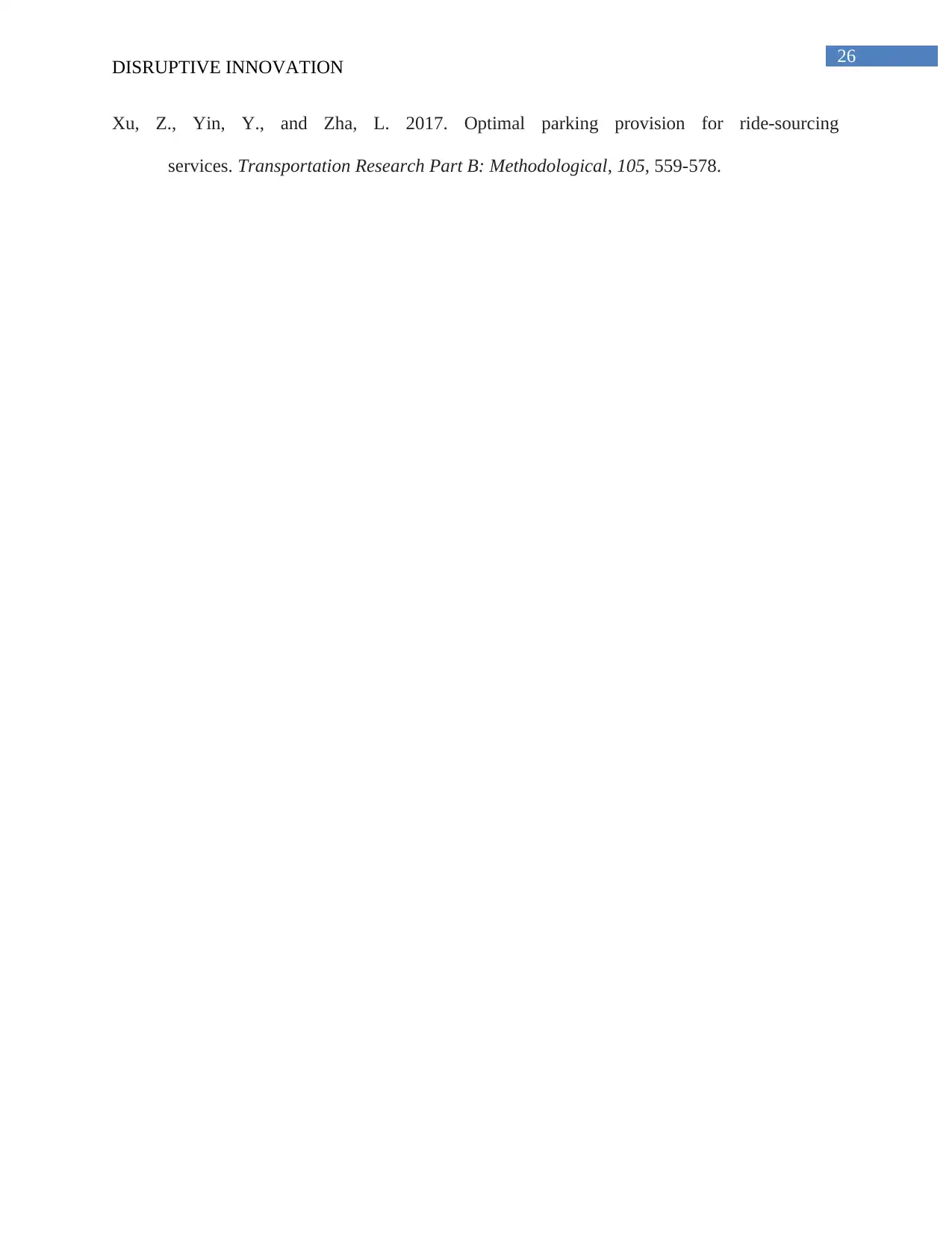
26
DISRUPTIVE INNOVATION
Xu, Z., Yin, Y., and Zha, L. 2017. Optimal parking provision for ride-sourcing
services. Transportation Research Part B: Methodological, 105, 559-578.
DISRUPTIVE INNOVATION
Xu, Z., Yin, Y., and Zha, L. 2017. Optimal parking provision for ride-sourcing
services. Transportation Research Part B: Methodological, 105, 559-578.
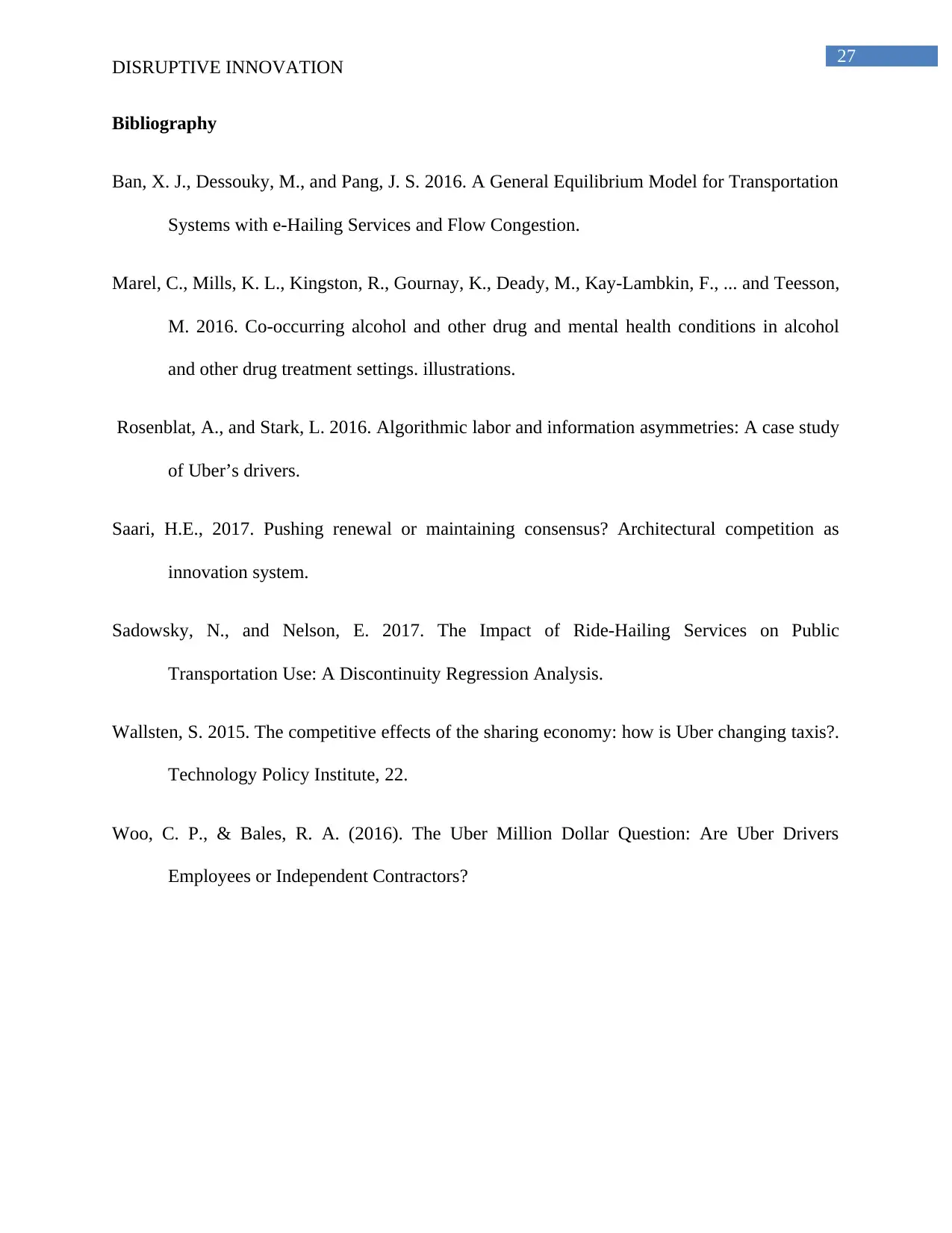
27
DISRUPTIVE INNOVATION
Bibliography
Ban, X. J., Dessouky, M., and Pang, J. S. 2016. A General Equilibrium Model for Transportation
Systems with e-Hailing Services and Flow Congestion.
Marel, C., Mills, K. L., Kingston, R., Gournay, K., Deady, M., Kay-Lambkin, F., ... and Teesson,
M. 2016. Co-occurring alcohol and other drug and mental health conditions in alcohol
and other drug treatment settings. illustrations.
Rosenblat, A., and Stark, L. 2016. Algorithmic labor and information asymmetries: A case study
of Uber’s drivers.
Saari, H.E., 2017. Pushing renewal or maintaining consensus? Architectural competition as
innovation system.
Sadowsky, N., and Nelson, E. 2017. The Impact of Ride-Hailing Services on Public
Transportation Use: A Discontinuity Regression Analysis.
Wallsten, S. 2015. The competitive effects of the sharing economy: how is Uber changing taxis?.
Technology Policy Institute, 22.
Woo, C. P., & Bales, R. A. (2016). The Uber Million Dollar Question: Are Uber Drivers
Employees or Independent Contractors?
DISRUPTIVE INNOVATION
Bibliography
Ban, X. J., Dessouky, M., and Pang, J. S. 2016. A General Equilibrium Model for Transportation
Systems with e-Hailing Services and Flow Congestion.
Marel, C., Mills, K. L., Kingston, R., Gournay, K., Deady, M., Kay-Lambkin, F., ... and Teesson,
M. 2016. Co-occurring alcohol and other drug and mental health conditions in alcohol
and other drug treatment settings. illustrations.
Rosenblat, A., and Stark, L. 2016. Algorithmic labor and information asymmetries: A case study
of Uber’s drivers.
Saari, H.E., 2017. Pushing renewal or maintaining consensus? Architectural competition as
innovation system.
Sadowsky, N., and Nelson, E. 2017. The Impact of Ride-Hailing Services on Public
Transportation Use: A Discontinuity Regression Analysis.
Wallsten, S. 2015. The competitive effects of the sharing economy: how is Uber changing taxis?.
Technology Policy Institute, 22.
Woo, C. P., & Bales, R. A. (2016). The Uber Million Dollar Question: Are Uber Drivers
Employees or Independent Contractors?
1 out of 28
Related Documents
Your All-in-One AI-Powered Toolkit for Academic Success.
+13062052269
info@desklib.com
Available 24*7 on WhatsApp / Email
![[object Object]](/_next/static/media/star-bottom.7253800d.svg)
Unlock your academic potential
© 2024 | Zucol Services PVT LTD | All rights reserved.





